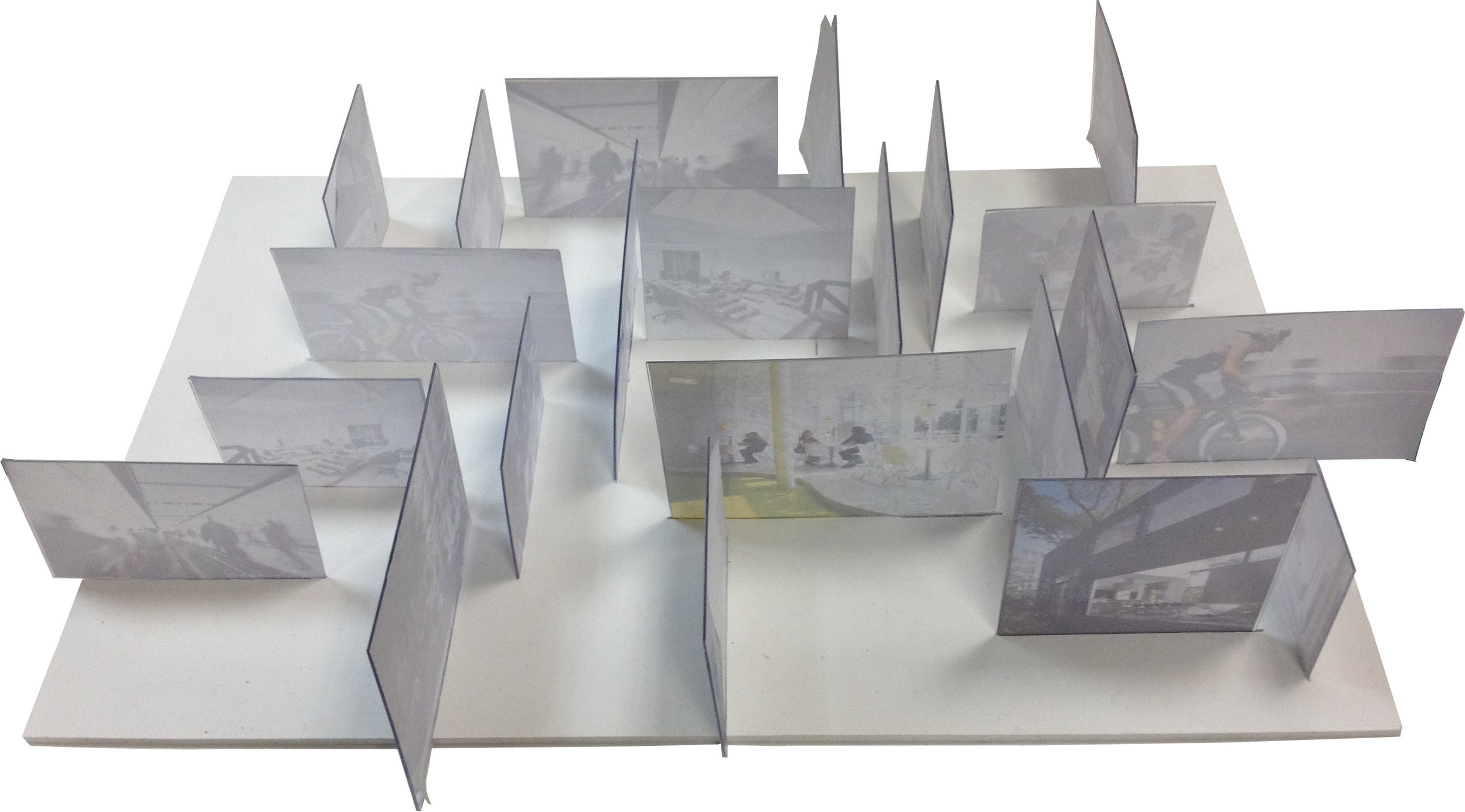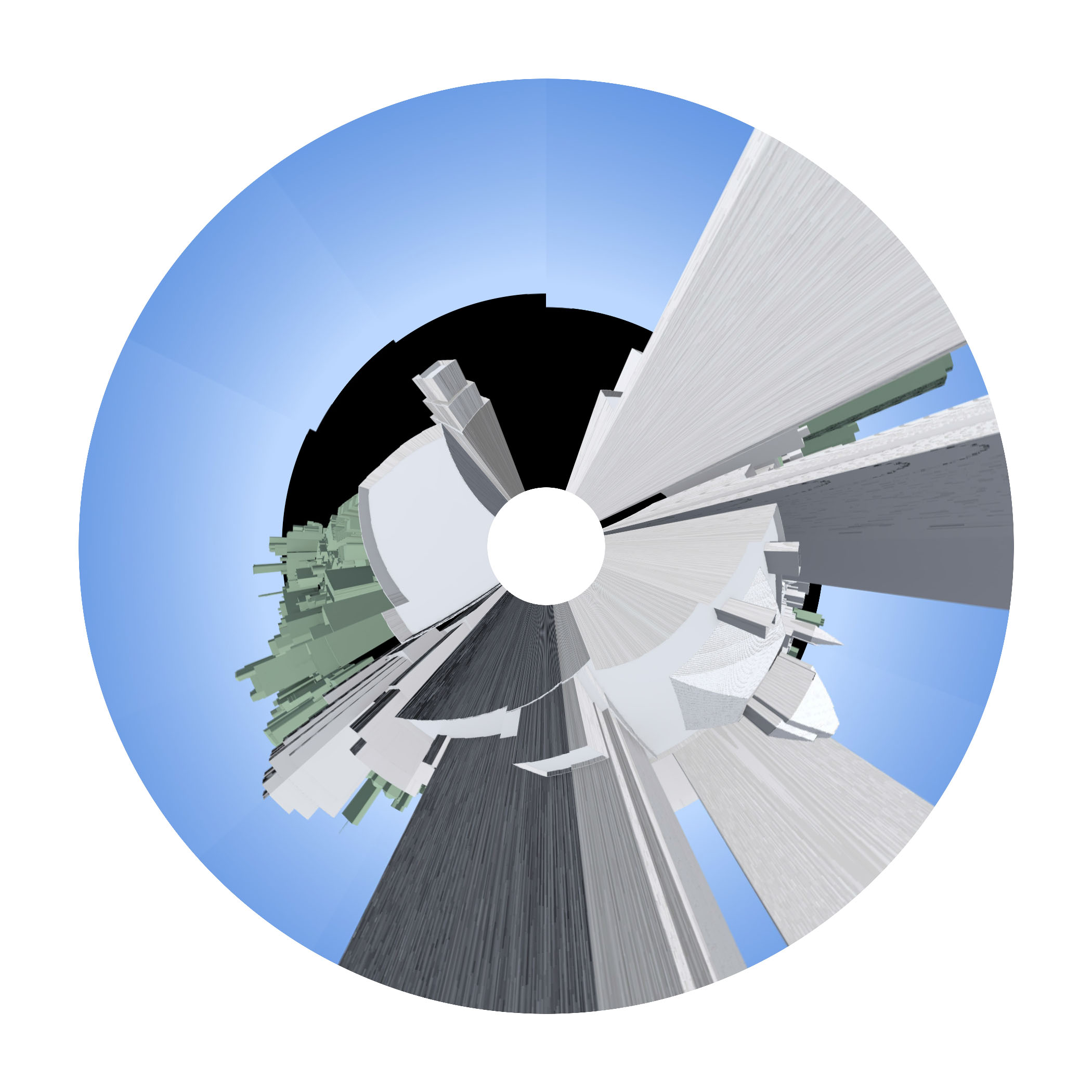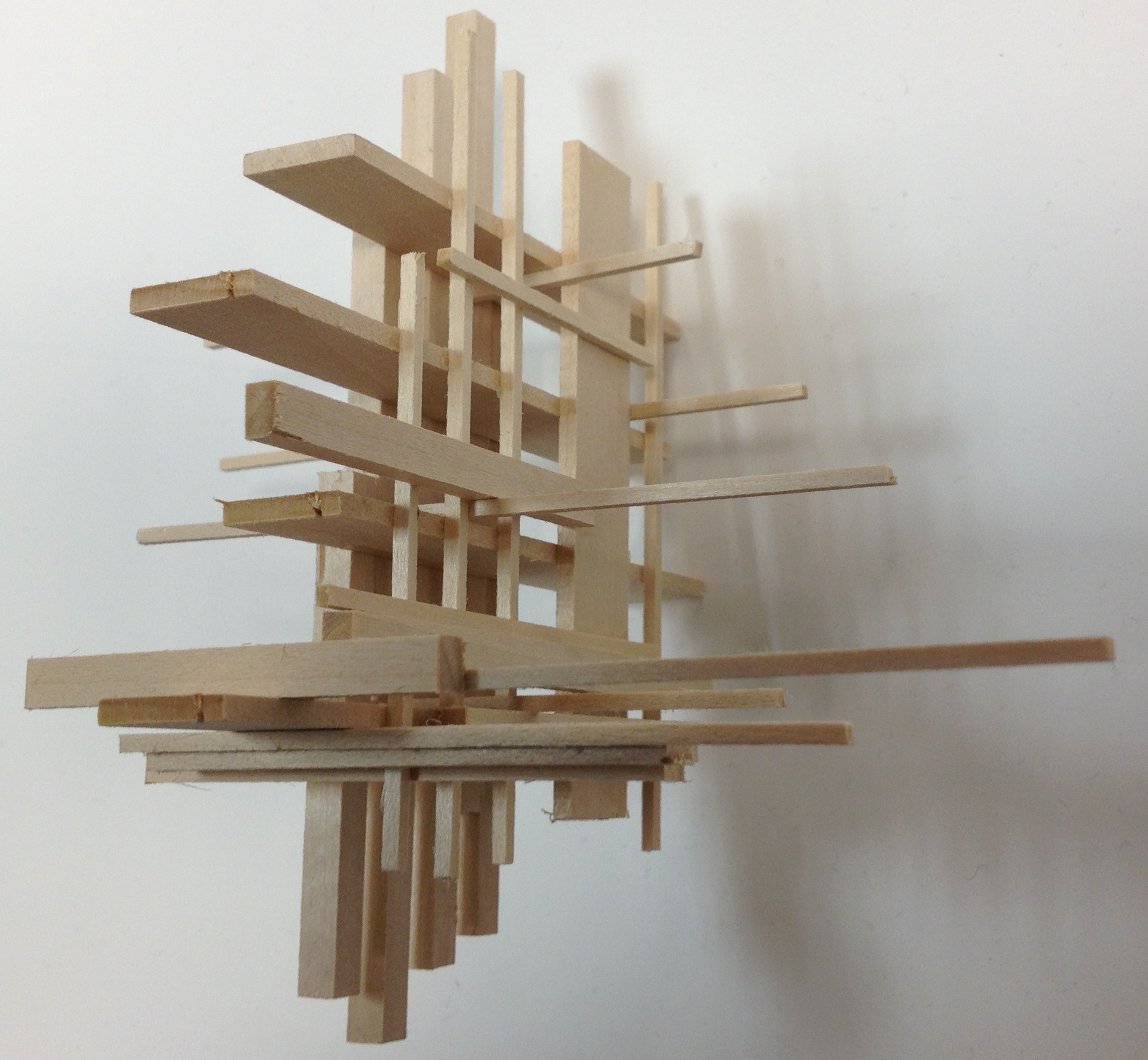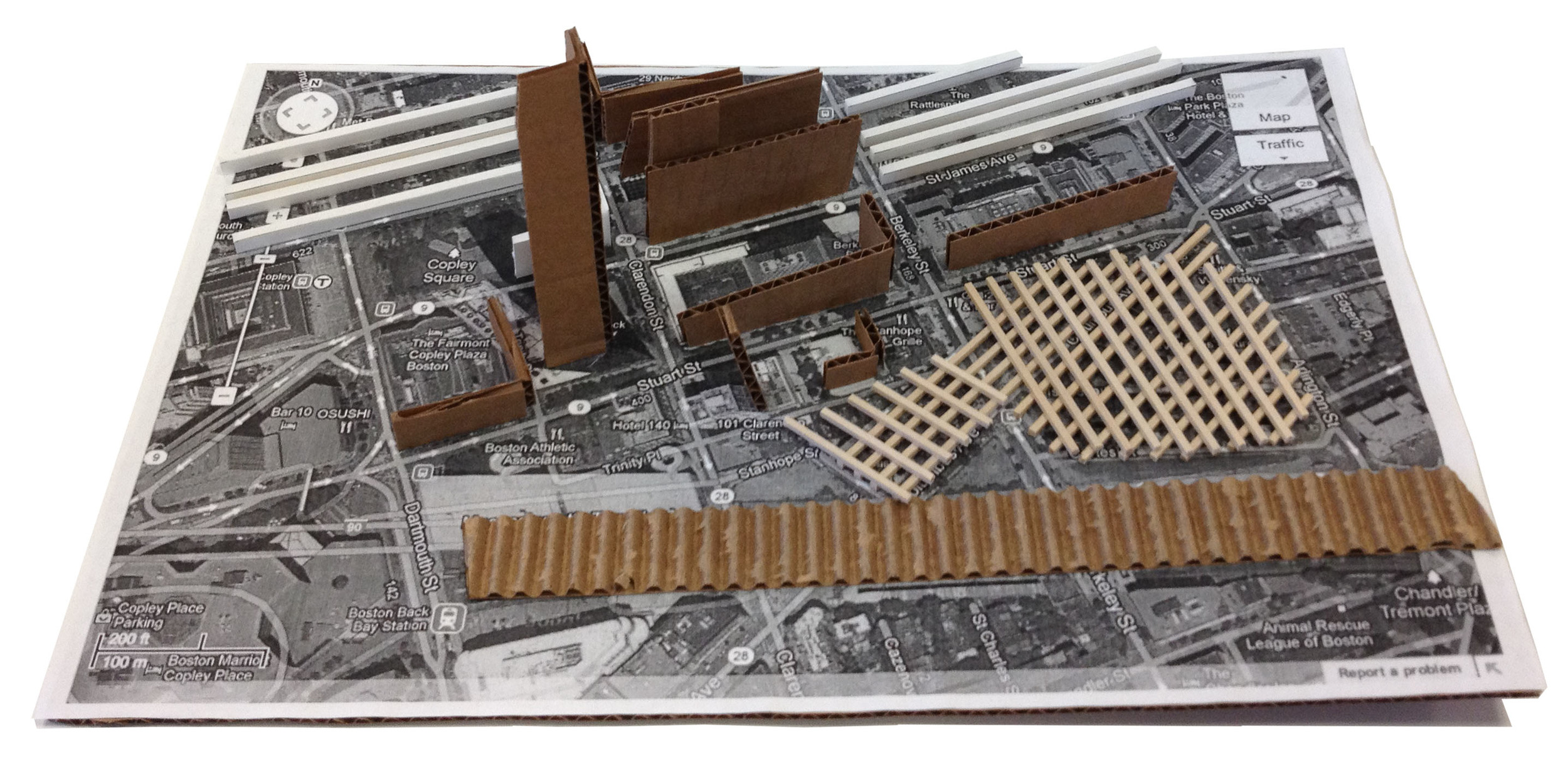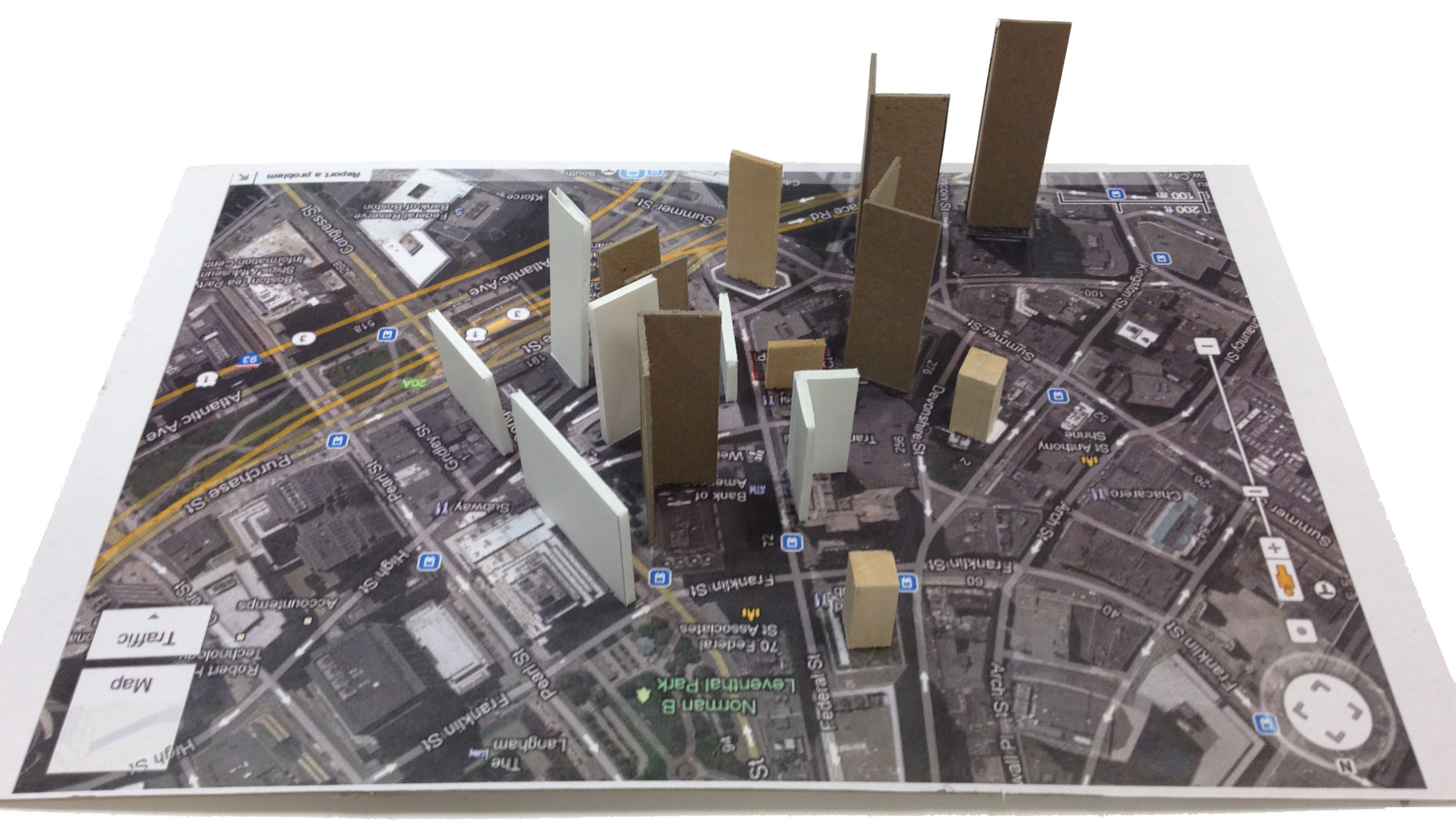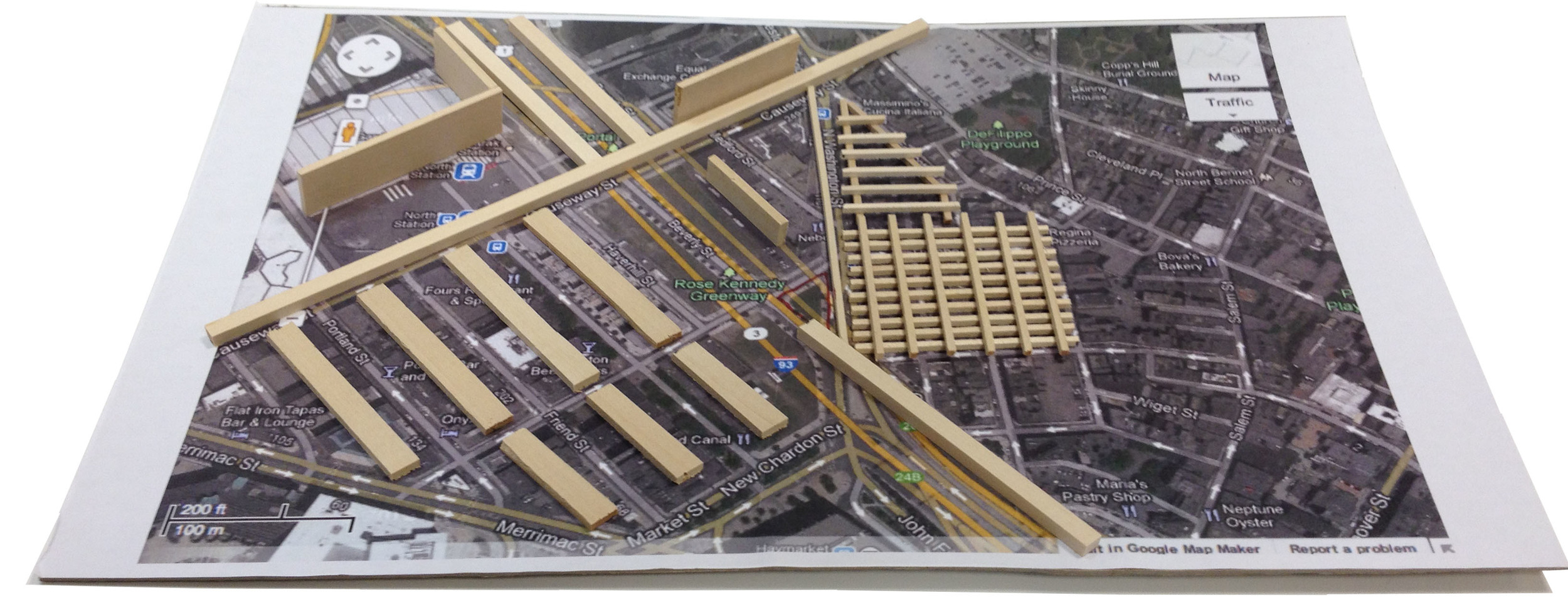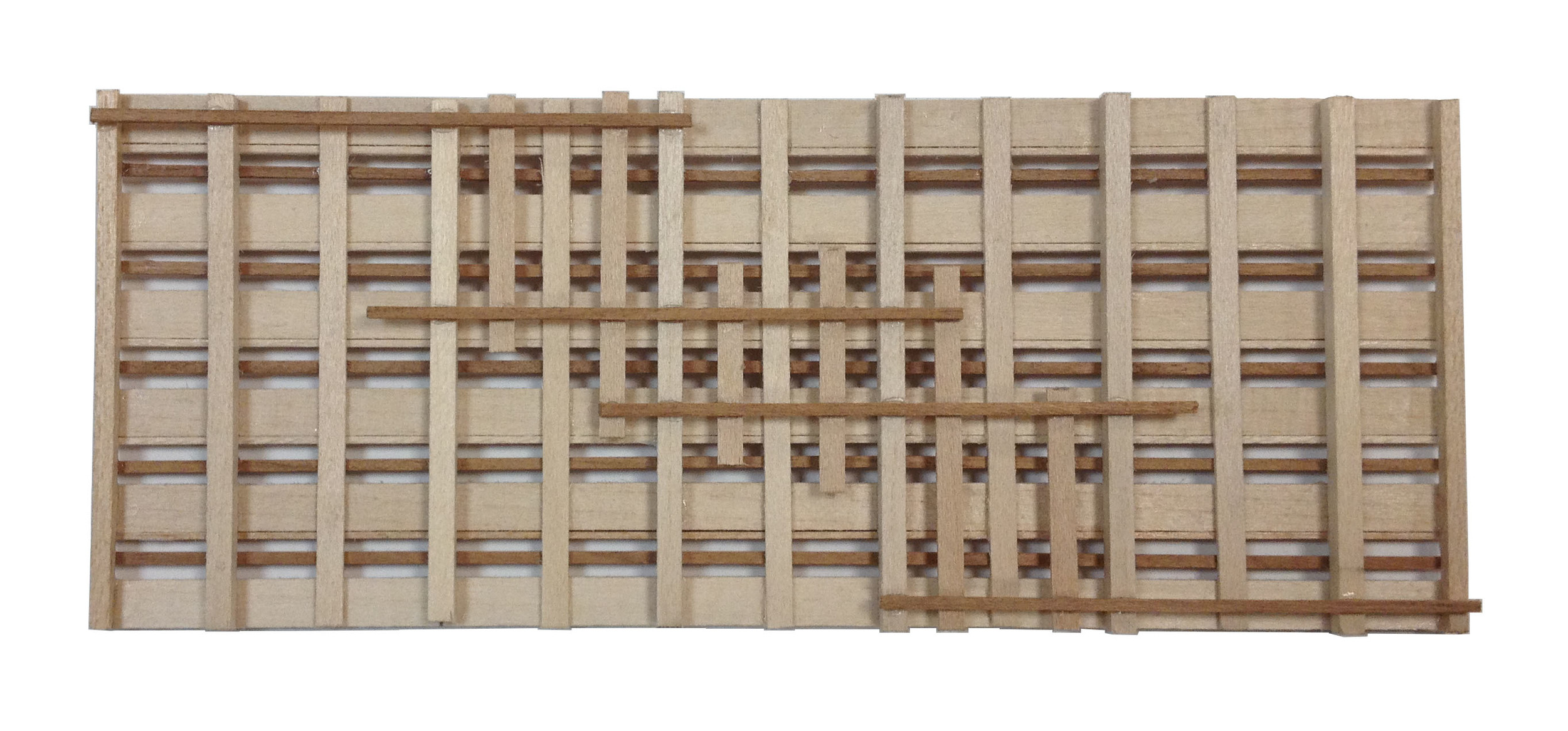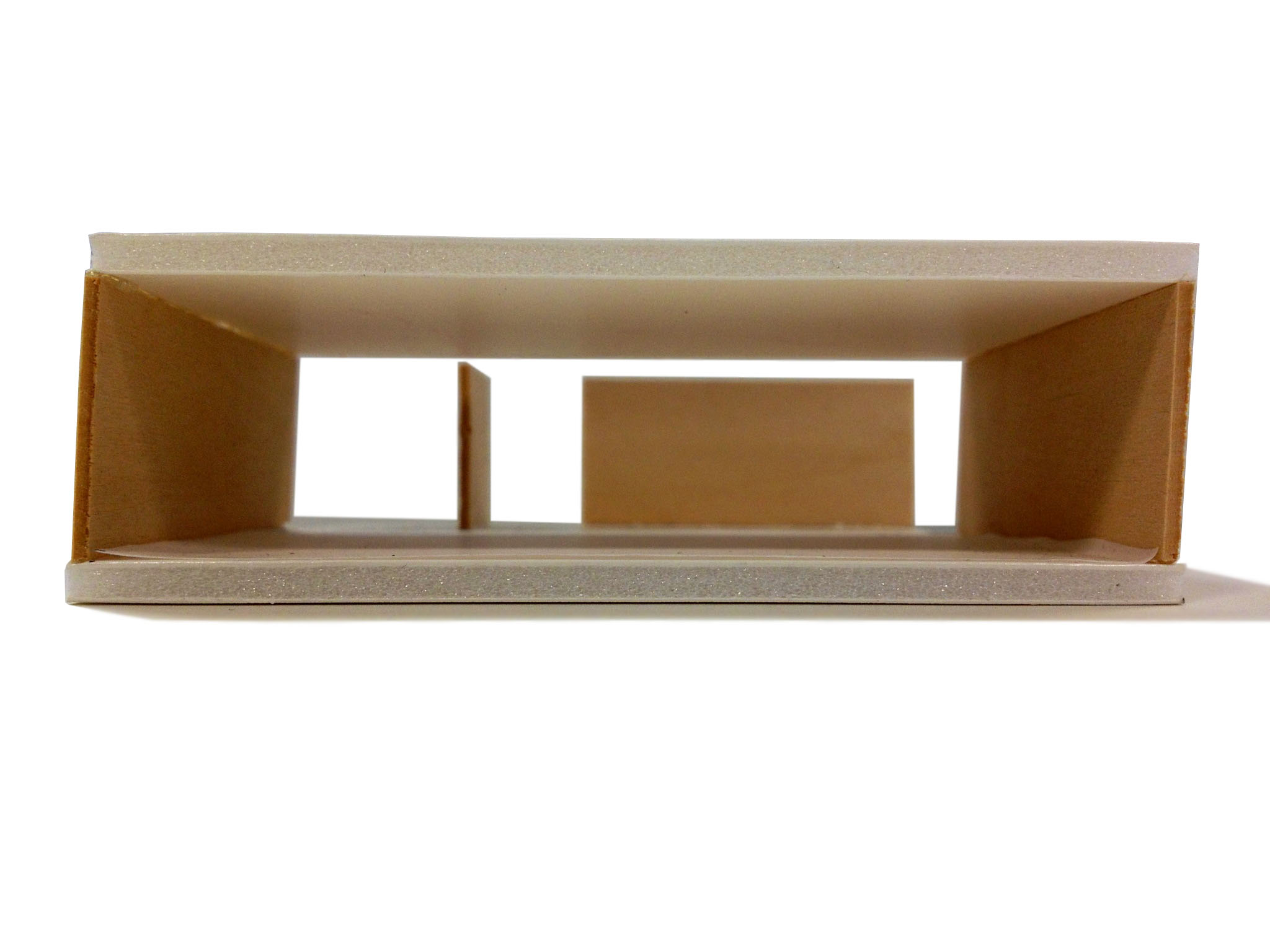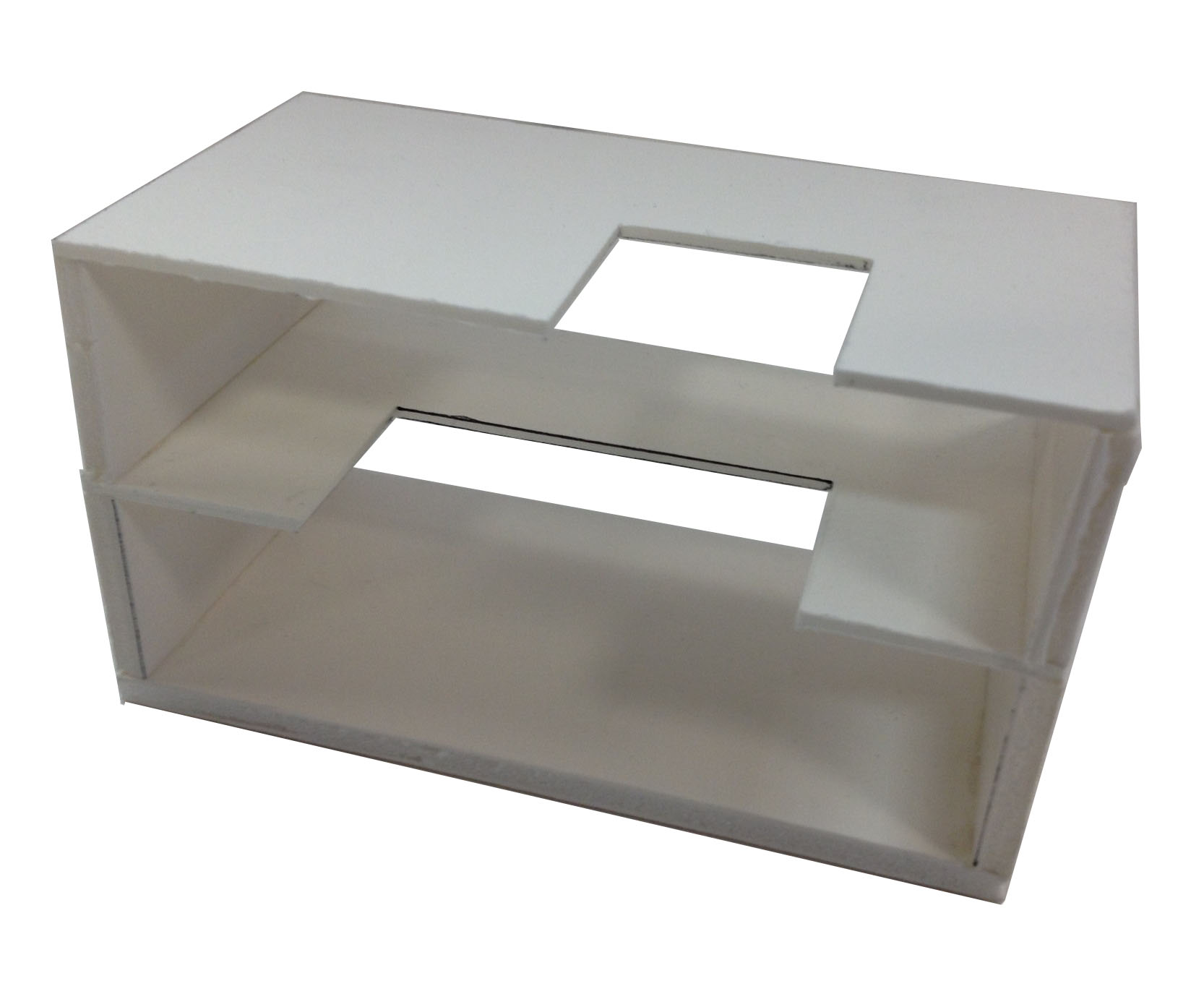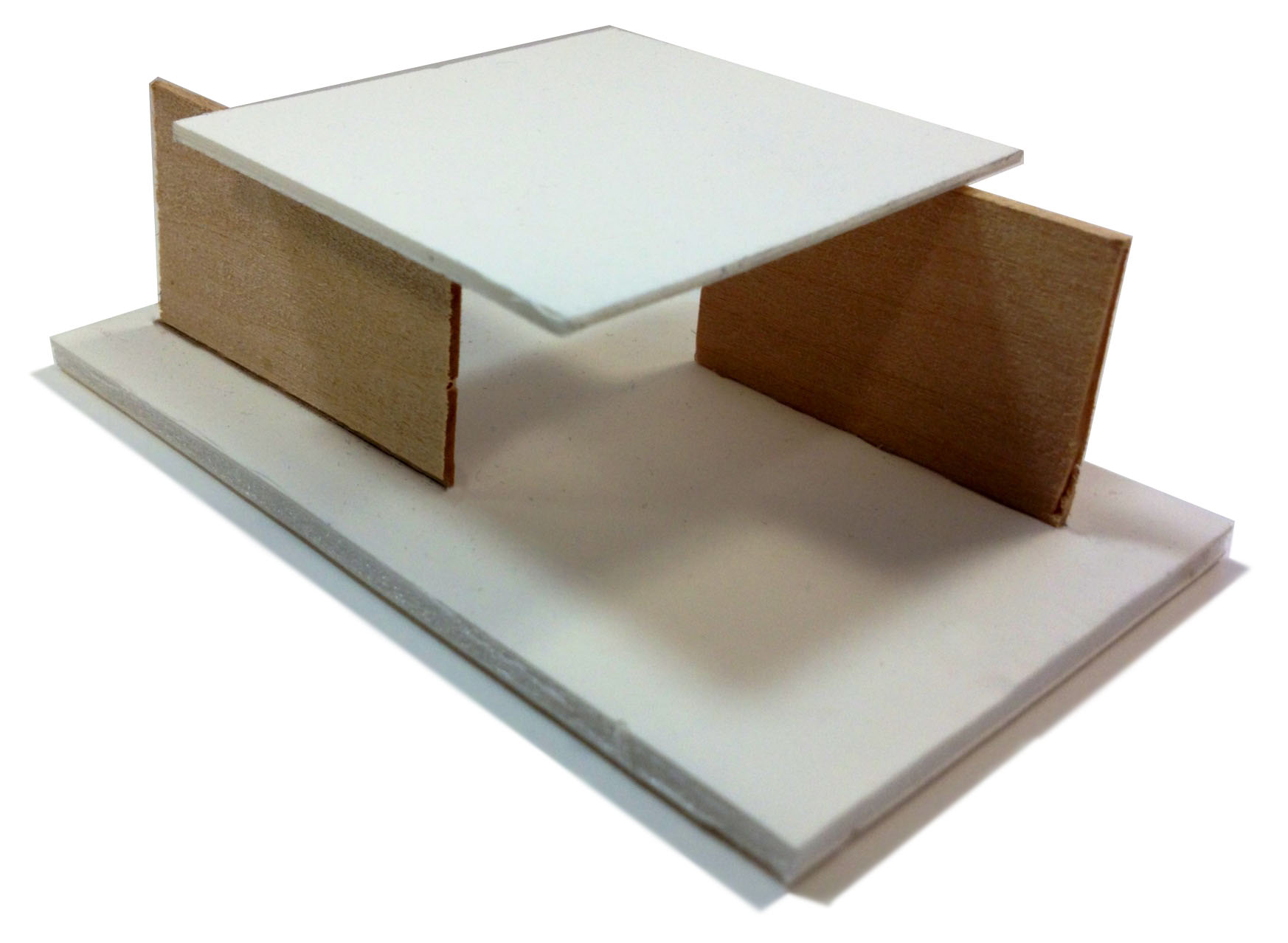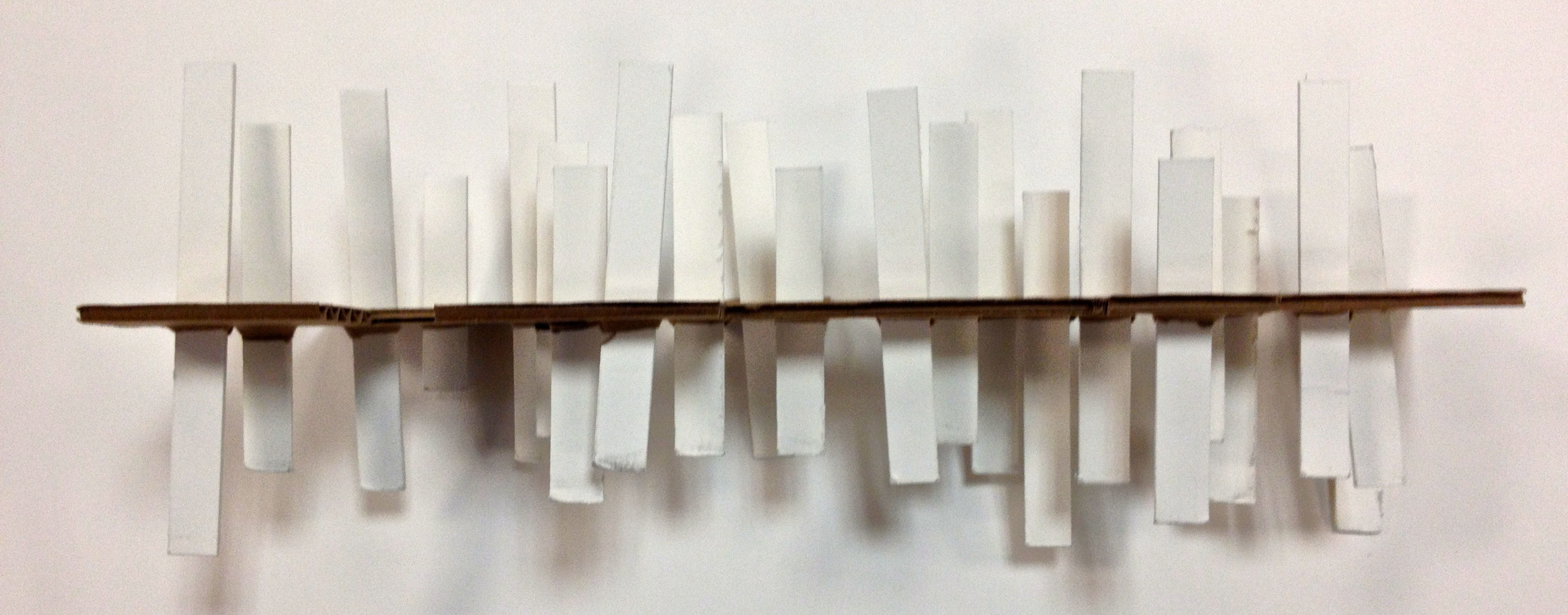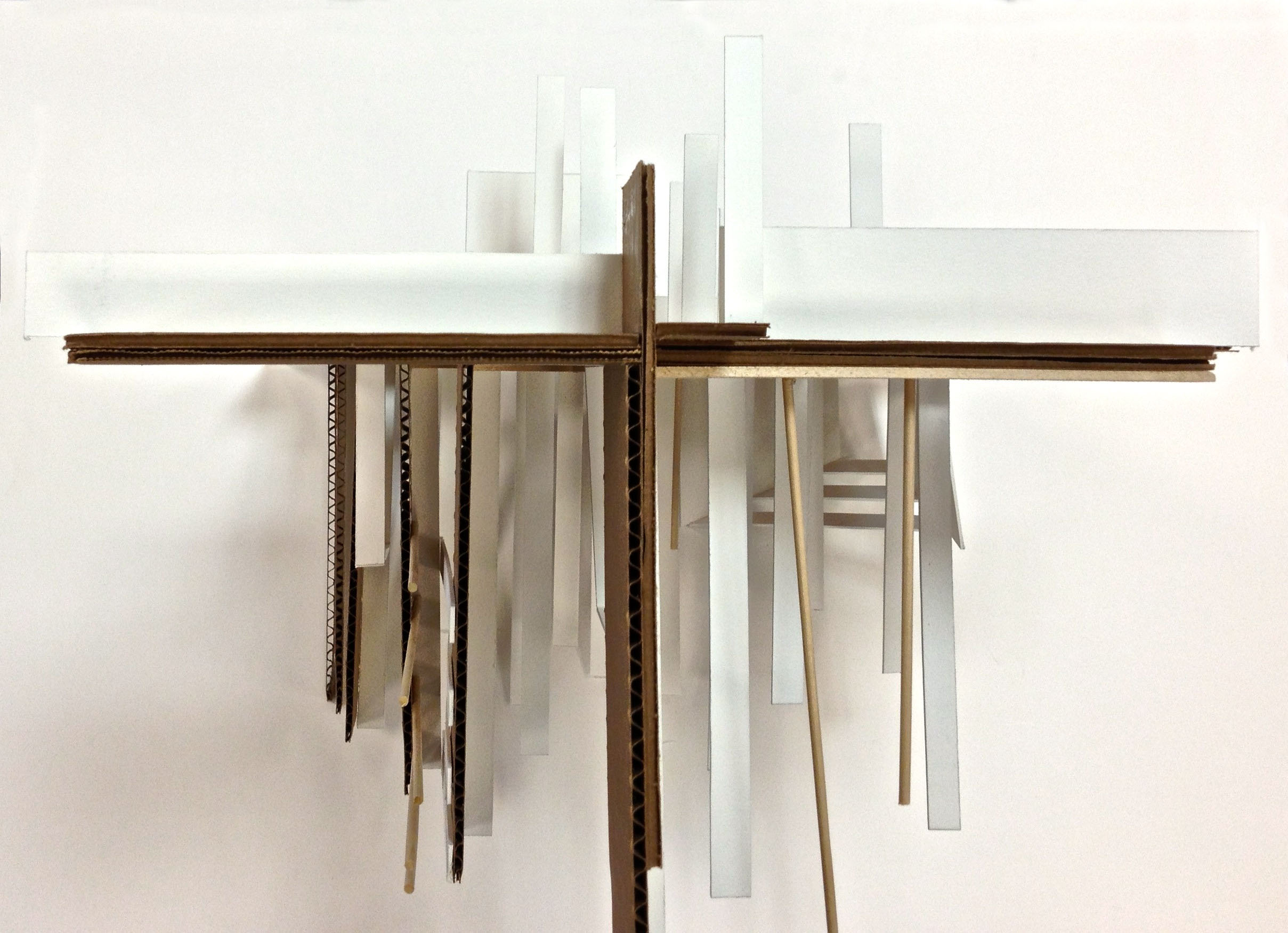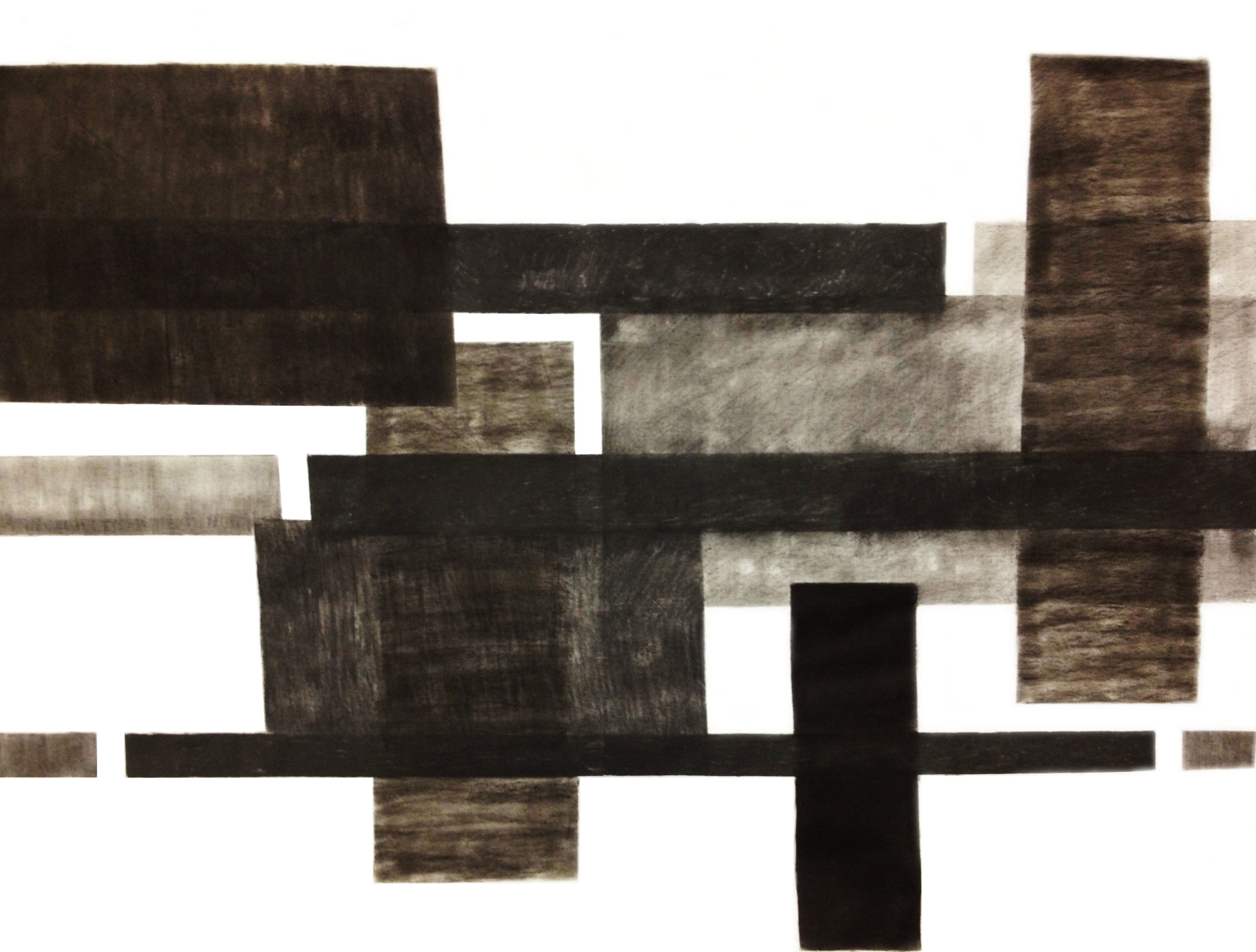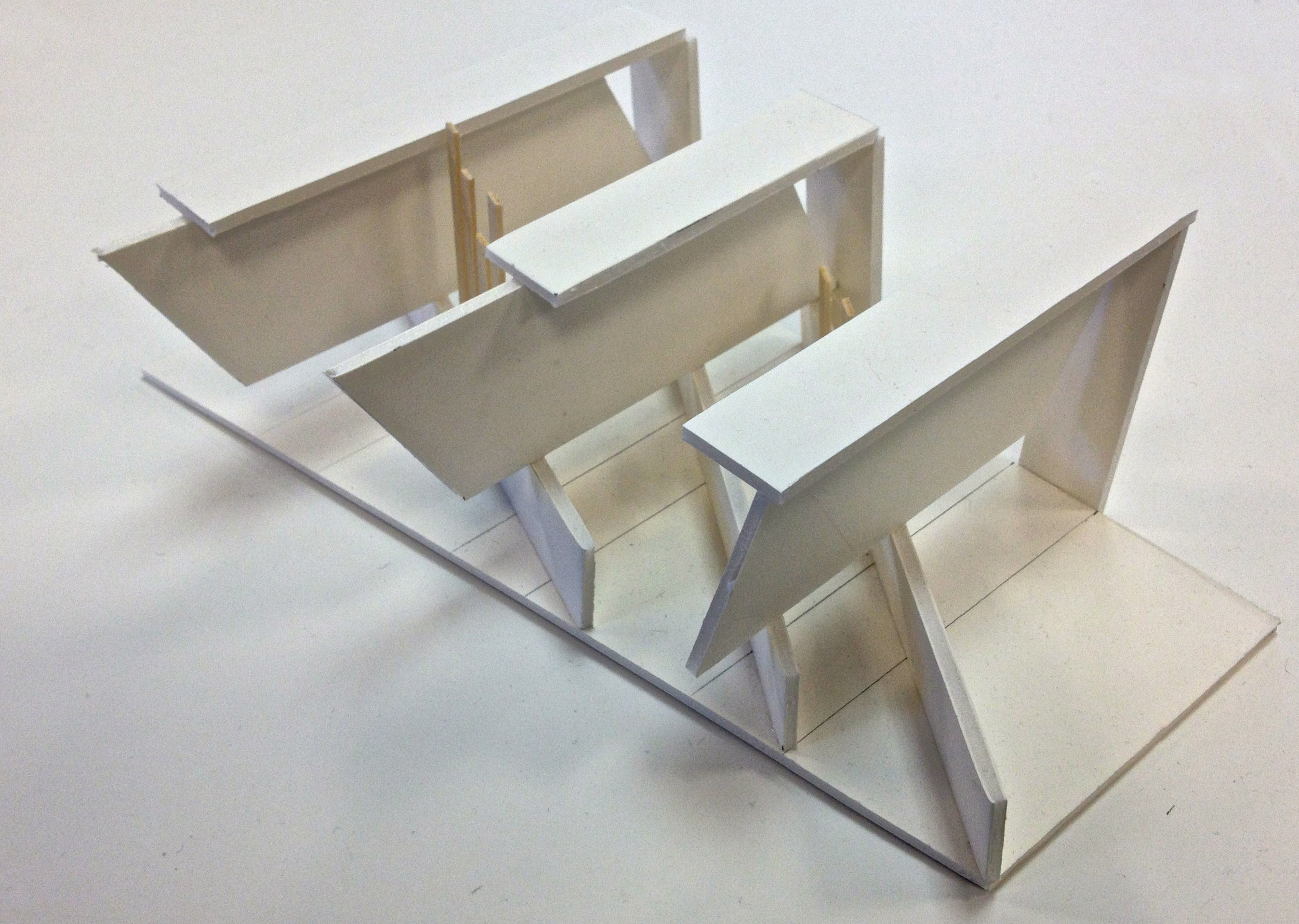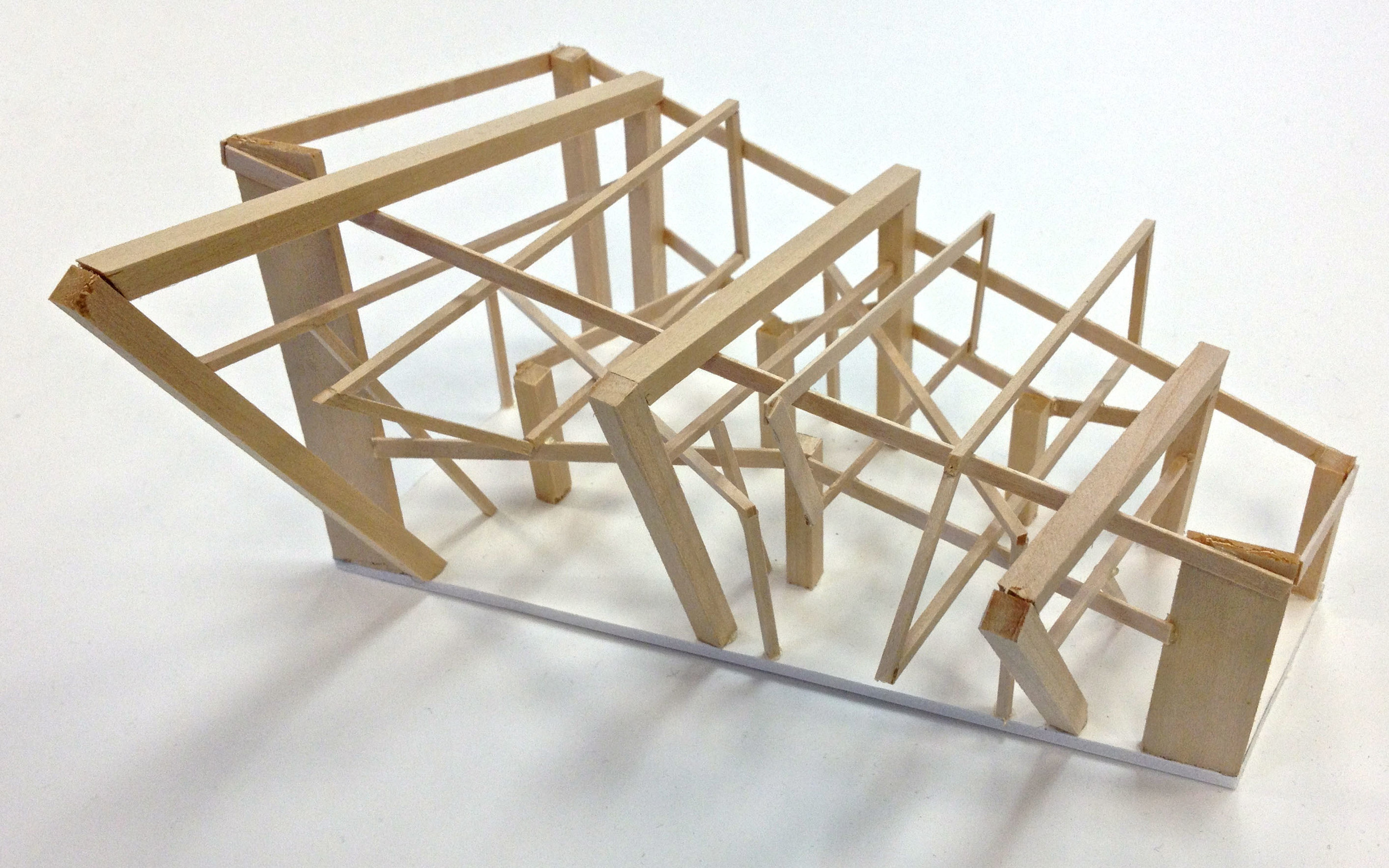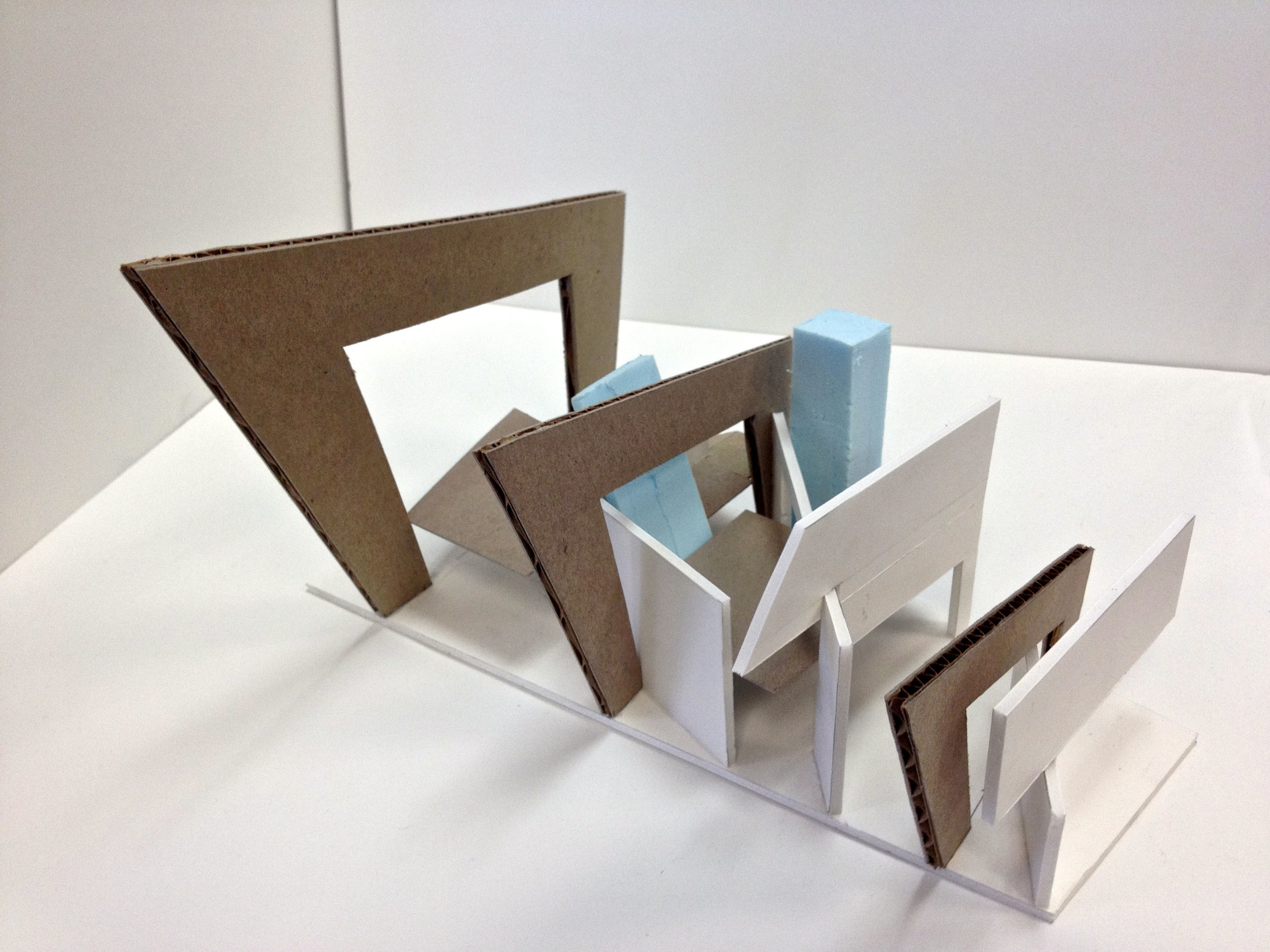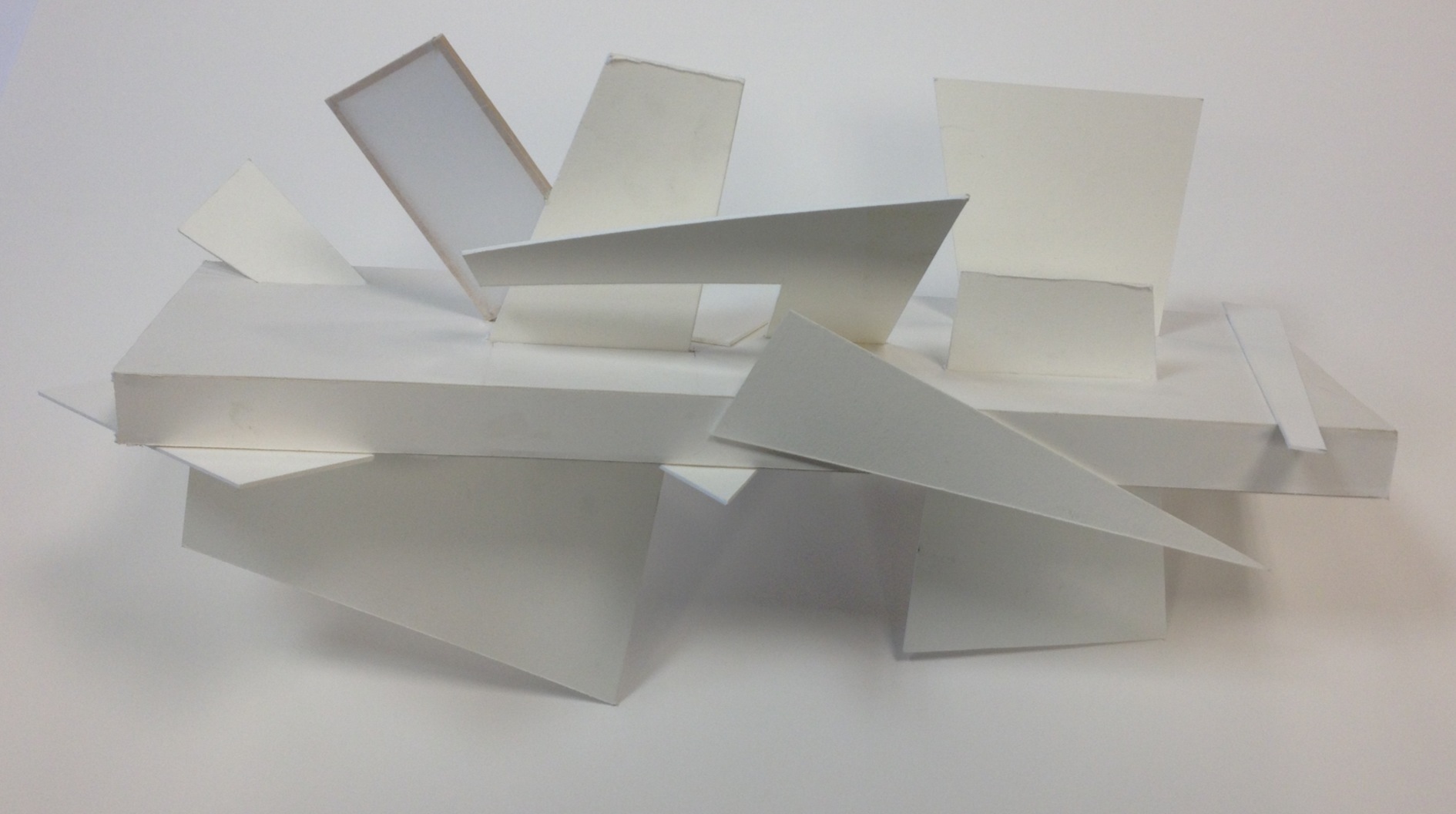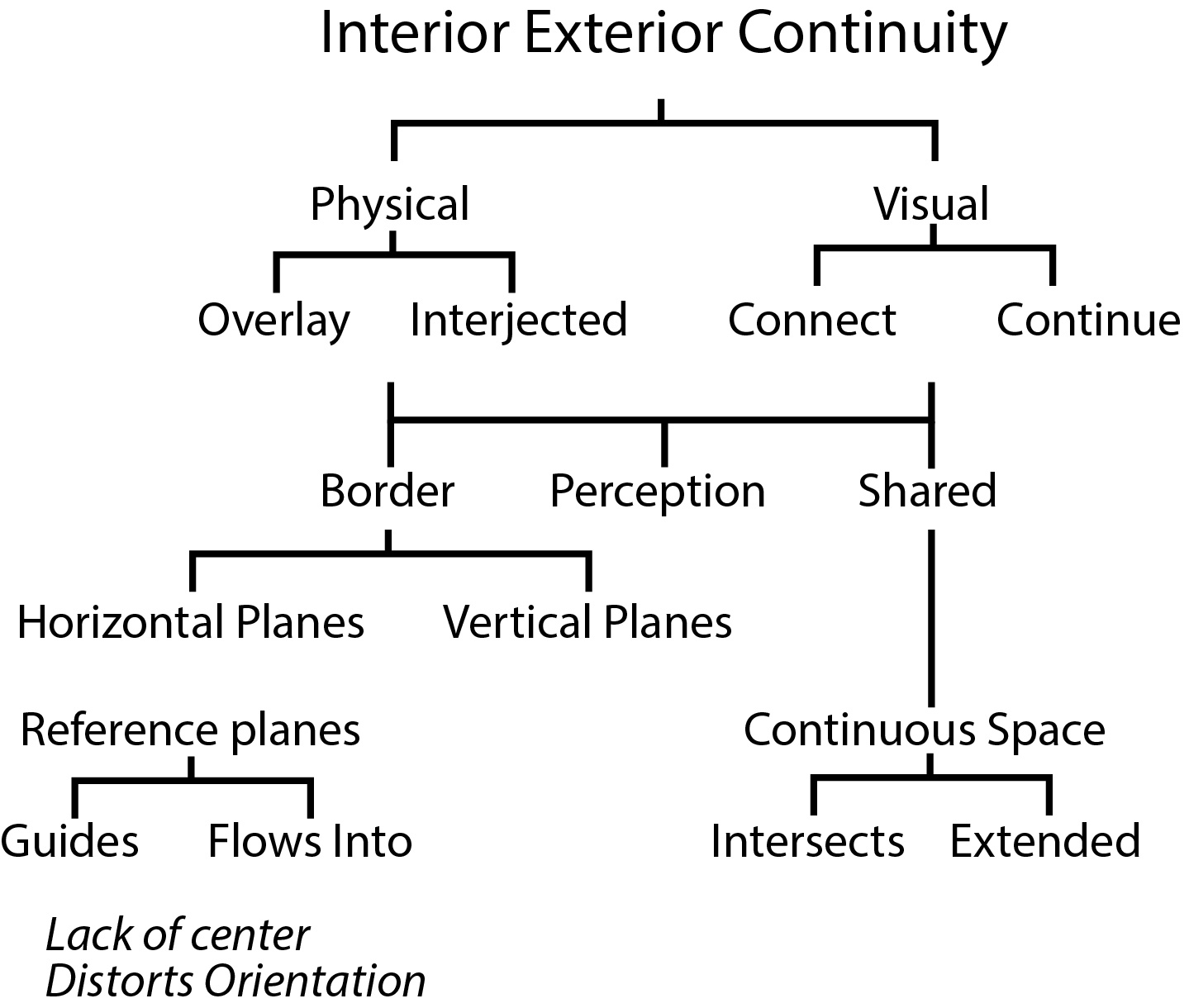Wandering down the street you come across a glass wall. As you get closer the view inside opens up to you and its activities spill outwards. As you enter through the circulation space, you see places for meeting, rest and gathering. They penetrate into your pathway. Few elements hint at borders between uses and nothing definite is apparent. As you walk forward you lean against a railing, noticing people below and above you are doing the same. You look outward and see different activities happening on each level and terrace. As you run your hands down the railings to the lower levels, different rooms and areas move into and away from your path of travel. You traverse down the path and reach a glass wall. You see beyond out to the exterior, there are columns and covered areas. The landscape beyond is halted by a garden wall, which acts as the partial limits to the covered areas. From the sides of the wall you can see out into the extends of the landscape beyond.
TP2: Program
TP: 2 Landmarks and Surroundings Analysis
In continuance of the site exploration it was necessary to observe the surrounding conditions. Utilizing waypoints the proposed site uses surrounding landmarks and buildings like the walls in the preliminary study models are used. These landmarks will pose as an untagible boundary that increases the perceived size of the space and creates a continuation of space.
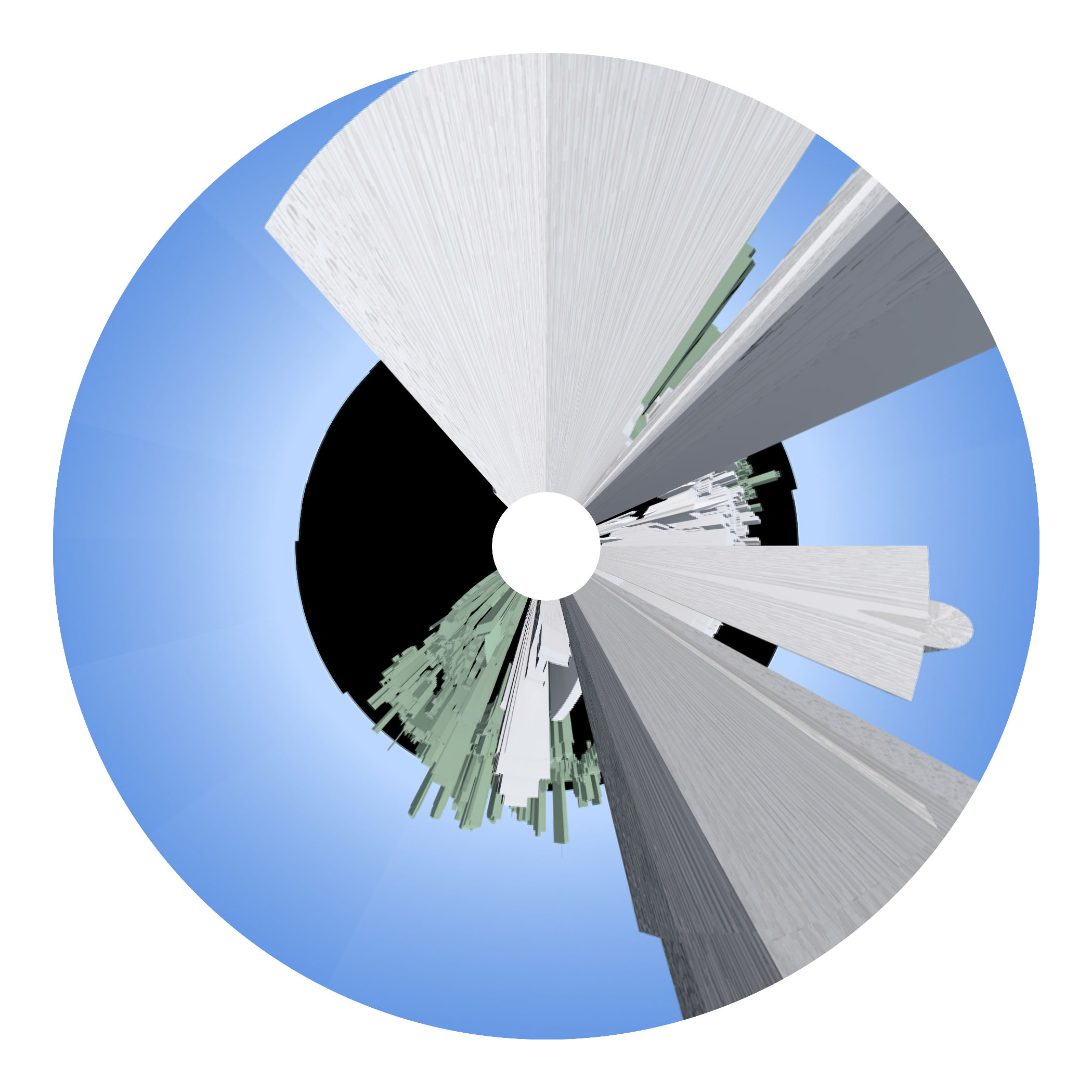
TP2: Site Analysis
The first abstract site mode shows the density and height qualities that were necessary for the chosen site. The wood grids represent low residentail areas while the longer horizontal pieces represent mid rise office and finally the tall upright sticks represent highrise buildings.
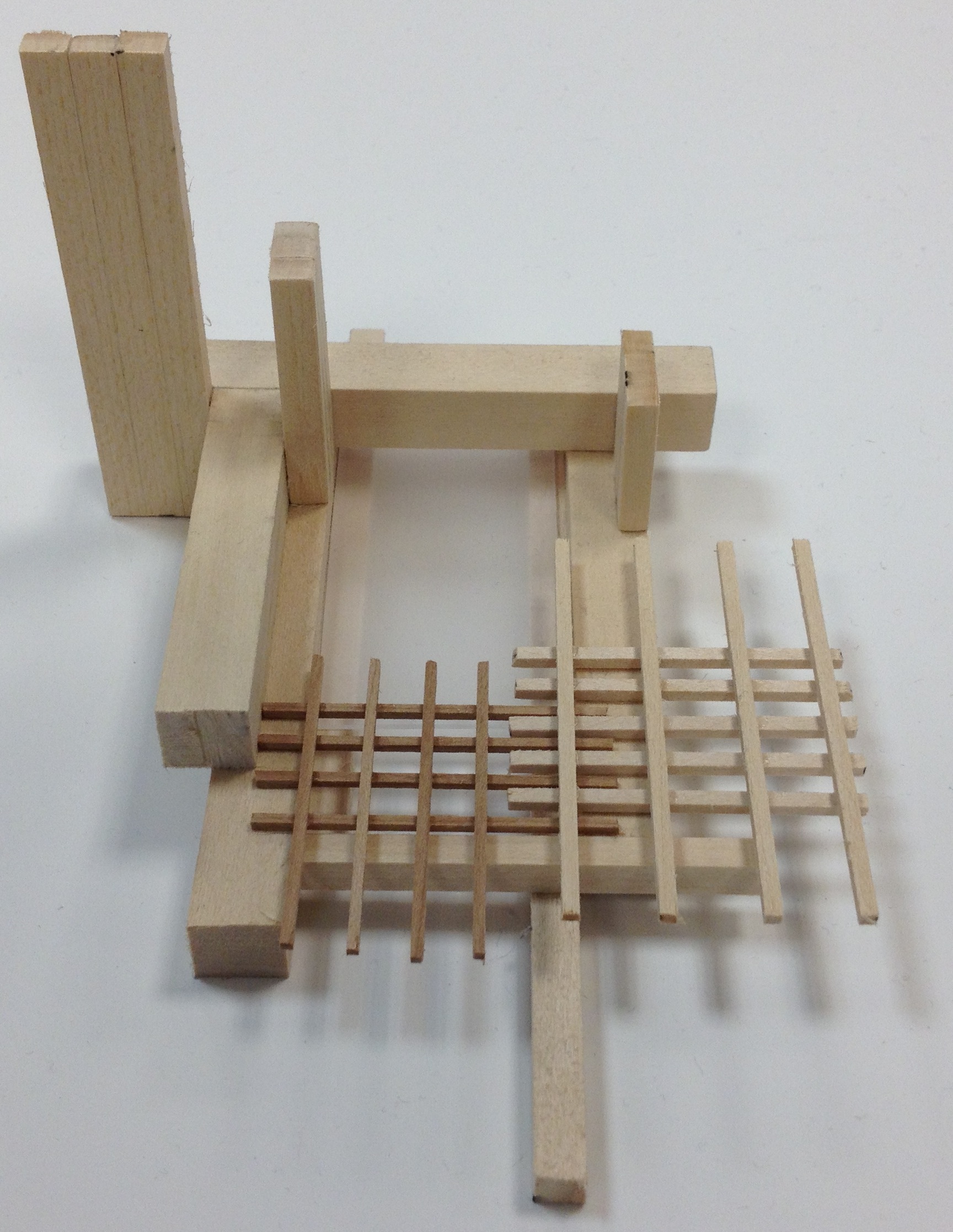
The second abstract site model shows the density and hight qualitites that were necessary for the chosen site in section. The grid represents the dense structure of the adjacent buildings and the more dispersed sticks represent larger and more open spaces.
TP2: Site
During the site explorationg process a series of site qualities were established. This consisted of a smaller site in the sense of square footage, and located within an area that was dense but also allowed for views beyond the immediate area. After studying three sites the site at 380 Stuart Site was chosen for its variety in height, density and program. This site is adjacent to neighborhoods that have landmark buildings density and areas for growth to use as references to mark the buildings limits and extends.
Site analyzed:
380 Stuart Street
Back Bay
This site satisfied the density qualitites necessary, the variety of heights, denisty and uses.
Site analyzed:
Fedaral Street and Milton Place
Boston Financial District
This site satisfied the density qualitites necessary but lacked a variety of heights, denisty and uses.
Site analyzed:
Valenti Square. North Washington Street and Beverly Street
Rose Kennedy Greenway
This site satisfied the small square footage but lacked a variety of heights, denisty and uses. The site was too open in it’s surroundings and lacked connections to areas around it.
TP2: Topic
The thesis topic was researched by a series of sketches and study models. The research of phenomenal transparency lead to precedent studies from Corbusier’s house at Garches, his League of Nations building complex and Mie van Der Rohe’s Barelona Pavillion. These examples are only a few of many that illustrate how architects manipulate space and its dimensional qualitites.

The sketches and model are experiments with layering overlapping and insinuating borders though planes and barriers. They play with what is foreground middle ground and background and create space without necessarily enclosing it.
These three models made of wood, foam core and matte board all create spaces with different types of spatial ambiguity. They show different spatial orders working together harmoniously. The first model uses a horizontal plane to create the first border and then the vertial plane beyond to act as a second extension of the space. The second model model creates spatial ambiguity vertically by acting first as a stacked rectangular atrium but then can also be equally viewed as an “L” shaped atrium. The third model uses shifted vertical planes to blur where the extents of the rectangular space is while the horizontal defines an inner square area that neither overpowers or destorys the other order.
RESUBMISSION: TP1: Assignment B: Contemporary Discourses / Compare and Contrast Essay 2
Reflection
The two readings chosen for this assignment inform my thinking about my thesis question by helping me to discover how I wish to research and support my thesis topic. What I wish to learn from my thesis question is about the continuity of interior and exterior spaces. Frampton’s article reveals the uses and general theories on tectonics, which I can apply to my thesis developing the use of a building’s material language to denote interior and exterior spaces. Blau’s article teaches how transparency, both literal and visual, can cause the occupant to feel as if the adjacent spaces are connected. This understanding provides a tool to aid my research in creating continuity between interior and exterior spaces.
The two sources “Introduction to Studies in Tectonic Culture” by Kenneth Frampton and “Transparency and the Irreconcilable Contradictions of Modernity” by Eve Blau, recognize a poetic non-visual non-literal aspect of tectonics. However, Frampton focuses on the “traditional” phenomenology of tectonics, while Blau speaks on the abstract perception of spaces. Frampton's theory is on the relationships between the user and the material and structure. He cites examples of Japanese architecture, religious buildings and municipal buildings and how materials define space and engage the inhabitant. Blau’s views are similar, however, she focuses on how the ambiguity of transparency that alters an individual’s perception of the space. The user’s perception of the space’s program is constantly in motion, much like a film montage of the building’s daily programmatic lifespan. The sources both speak to how tectonics are used to create literal and phenomenological space but they differ in their abstraction of it. Frampton's focus if on the physical qualities of the materials but Blau focuses on the phenomenas that occur in between the viewer and material.
In Frampton’s “Studies in Tectonic Culture” he asserts that we view space by reorganizing it based on past knowledge, that our movement into space defines it, and that structure and construction can vary the space’s expression. Frampton claims that based on our past experiences we reorganize and view a space as it has been before and theoretically should be now. “The body reconstitutes the world through its tactile appropriation of reality” (Frampton 1995, 10). He goes on to argue that tectonics create a defined space that we evaluate while we move forward into its volumes. “Our concept of space is determined by the frontalized progression of the body through space in depth” (Frampton 1995, 11). Frampton believes that a building’s expression can vary and is defined by subtle changes in its structural and material relationships. “Combinations of structure and construction could become the occasion for a subtle variation in expression” (Frampton 1995, 20). His views are constrained to a more traditional view of tectonics, one where the literal guides perception.
Eve Blau’s “Transparency and The Irreconcilable Contradictions of Modernity” argues that tectonic transparency creates literal and phenomenological spaces that have a complex layering, that move between realism and abstraction. Blau also states that these layered spaces have structural systems that when both visually and literally join they become a fully integrated work. Blau asserts that the layering of juxtaposed spaces causes them to blur into one another creating a complex interpretation of which space is positioned, without favoring one over another. One example she draws heavily upon is the Barcelona Pavilion where the walls and rooms are used as association points and not literal barriers. The Pavilion uses the juxtaposed spaces to bleed foreground and background together. “A quality of spatial organization that is ambiguous, generated by the simultaneous perception of different spatial locations and superimposed forms that appear to interpenetrate without optically destroying each other” (Blau 51). She argues that the spaces move between realism and abstraction because of the context in which they are viewed in relation to the whole of the building. For example a buildings layout can be viewed as a montage of different uses. “A conception of transparency as a function of montage: a compositional strategy of de-contextualization and re-contextualization the problematized and foregrounds the dialectical relationship between realism and abstraction” (Blau 52). Blau claims that when the literal structure and visual structure intertwine the result is a form that is perfectly complete as a whole. For example, “Mies integrates his two structural systems visually so that, perceptually, the discrepancies between them become invisible and the whole seems to cohere into a perfectly balanced and fully integrated autonomous work of art” (Blau 57). Her views on perception are founded in the abstract and how clarity can be altered and questioned.
As discussed, tectonic expression is prominent in both articles but the idea differs in how its use is executed. Kenneth Frampton takes a more traditional approach on how tectonics and materiality are expressed. His views are more realistic than abstract due to the concept of how materials express the space and move the person throughout it. Eve Blau discusses using transparency to blur and restructure the spaces causing the person to constantly be reassessing their understanding of the space. Her views on perceived space and programmatic uncertainty create an abstract dynamic dialogue between the user and the designed layout. Her approach differs from Frampton because the phenomenas she tries to explain cause the user to read in between the structure and materials of the building. Frampton asserts that the actual materials are what the user reads to create the space. The two approach's main difference is their focus on the building displaying what it's spaces are versus the user seeing the building's spaces as what they think they are. Both articles articulate the profound influence different types of tectonics have on the occupant.
Bibliography
Blau, Eve. “Transparency and the Irreconcilable Contradictions of Modernity,” PRAXIS 9 (fall 2007): 50-59
Frampton, Kenneth. “Introduction to Studies in Tectonic Culture: The Poetics of Construction in nineteenth and Twentieth Century Architecture” Edited by John Cava (Cambridge and London: MIT Press), 1-27.
RESUBMISSION: TP1: Summer Assignment: Architectural History or Landscape History?
“Architectural History or Landscape History?”By Dell Upton, University of California Berkeley
- Citation: Dell Upton. “Architectural History or Landscape History?” Journal of Architectural Education. (1984-), Vol. 44, No. 4. (Aug., 1991), pp. 195-199.
- Argument: Upton argues that architectural history has been a biography of designers and instead should encompass human experience and social interaction to evaluate work.
- Author: Dell Upton was educated at Colgate and Brown. He earned his Ph.D. American Civilization, at Brown University; a M.A. American Civilization, at Brown University and a B.A. History, English, at Colgate University. He is a Professor of various courses focusing on the architectural and the cultural. He was a consultant and chief catalogue essayist for the Metropolitan Museum of Art’s 2000 exhibition Art and the Empire City: New York, 1825-1861. Upton has a multitude of published works including: Another City: Urban Life and Urban Spaces in the New American Republic 2008, Architecture in the United States 1998, Holy Things and Profane: Anglican Parish Churches in Colonial Virginia 1986. He is also working on a world history of architecture. (http://www.arthistory.ucla.edu/people/faculty/dupton/)
- Method: Upton argues that architectural history has been a biography of designers and instead should encompass human experience and social interaction to evaluate work. Dell Upton makes his argument by describing how previous accounts of architectural history are a biography of the designer and builder. He asserts that each time period is viewed and marked by a certain building or designer. This way of defining history lacks a focus on the human made environment. He cites "Sociologists of the professions" but he does not specifically name any in particular, who support his claim. For example, “defining a distinctive realm of expertise and of devising a mechanism for limiting entrance to its practice” (Upton 1991, 2). He claims this to be how professionalism started and the tools it used to be more exclusive. The universal notion of style has been refined and preserved since the renaissance by people who are not part of vernacular and who gained professional status from certain education and training, most notably scholars who are also professionals in the field. Upton's claims that supporters of the "self-interested paradigm" were from the middle class and accepted this cultural hierarchy which explains why some works are considered aesthetically pleasing and others not.
- Key words: Human landscape, cultural landscape, perception, vernacular
- mind map
- Evaluate:
- Sources selected: “Aesthetics as an Intellectual Network” by Casey Haskins and “Space and the Perception of Time”by Victoria Meyers
- Rationale: “Aesthetics as an Intellectual Network”by Casey Haskins branched off from Upton’s keyword of cultural landscape in how high cultured professionals dictate what is considered aesthetically pleasing and what styles are deemed successful. He argues that aesthetics of all kinds including art and music are monopolized and governed by a select group of high cultured educated professionals. Haskins believes philosophical aesthetics is shared throughout all of the creative fields and he argues that they play off each other. “Space and the Perception of Time”by Victoria Meyers branches off the keyword perception that I selected from Upton’s article. She discusses how light, shadow, and textures affect the user’s perception and how it can be manipulated. Haskin’s ideas of high culture contribute to Upton’s thesis by reaffirming his claim that professionals in their fields produce our preconceived notion of aesthetics. While Meyer’s concepts on perception outlines the characteristics needed to create the human experience and social interaction Upton asserts it is needed to evaluate architectural work.
- Bibliography
Dell Upton. “Architectural History or Landscape History?” Journal of Architectural Education. (1984-), Vol. 44, No. 4. (Aug., 1991), pp. 195-199.
Haskins, Casey. "Aesthetics as an Intellectual Network ." Journal of Aesthetics & Art Criticism 69, no. 3 (Aug 2011): 297-308.
Meyers, Victoria. "Space and the Perception of Time." Journal of Architectural Education 53, no. 2 (Nov 1999): 91-95.
Assignment E: Bibliographic Essay - Revised
Assignment F1: Mini Conference Feedback
The results of the feedback were as follows: the many categories of transparency were broken down and briefly analyzed and then discussed how they would be focused on and then utilized as a whole. The categories:
Color Foreground background oscillation Levels of transparency to opacity Layering Spatial organizational transparency Gestalt composition of form Shadow Reflection
One of the eight categories was the one I had been focusing on. This elemental break down demonstrated the most effective way to explain my process. All parts of transparency needed to be analyzed and one focused on. Once this was accomplished I can explain the spatial transparency I'm interested in focusing on and then explain how the other categories inform the one. This will reaffirm my category decision and also help me to better understand it.
All in all I feel the mini conference was helpful in bringing the presentation and thesis weaknesses to the surface. Going forward I plan to reevaluate the hierarchal elements of transparency and clearly display their effects on one another. Other sources that were discussed will also be helpful for me to further explore the topic.
Assignment F: Mini-Conference Presentation
Intro Statement:
Visually, spaces are perceived with transparency when they have overlays, extensions and their boundaries blur at certain points. These observations are found throughout various works and they concentrate on visual perceptions of space. One of these concepts illustrated by Eve Blau includes abstracted spaces that create an image similar to cubist paintings where the user is constantly viewing spaces that intertwine and relate. The relationships are formed from the basic roots in tectonic style that controls how one sees a room such as heavy or light, shallow or deep. These different methods of overlaying and showing ambiguity abstractly within spaces merges and shifts programs to alter our ideas on how these spaces are associated. These perceptions not only include overlays but a sense of the beyond and the shortening and the extending of a space. Ambiguities within spaces that make associations between two or more areas are referenced to explain the phenomenal perceptions of a larger layout. The occupant’s assessments and perceptions about a space is directly associated with spatial relations, ambiguities, tectonics, and perceived barriers. These aspects all inform and contribute to the ideas behind the perception of phenomenology.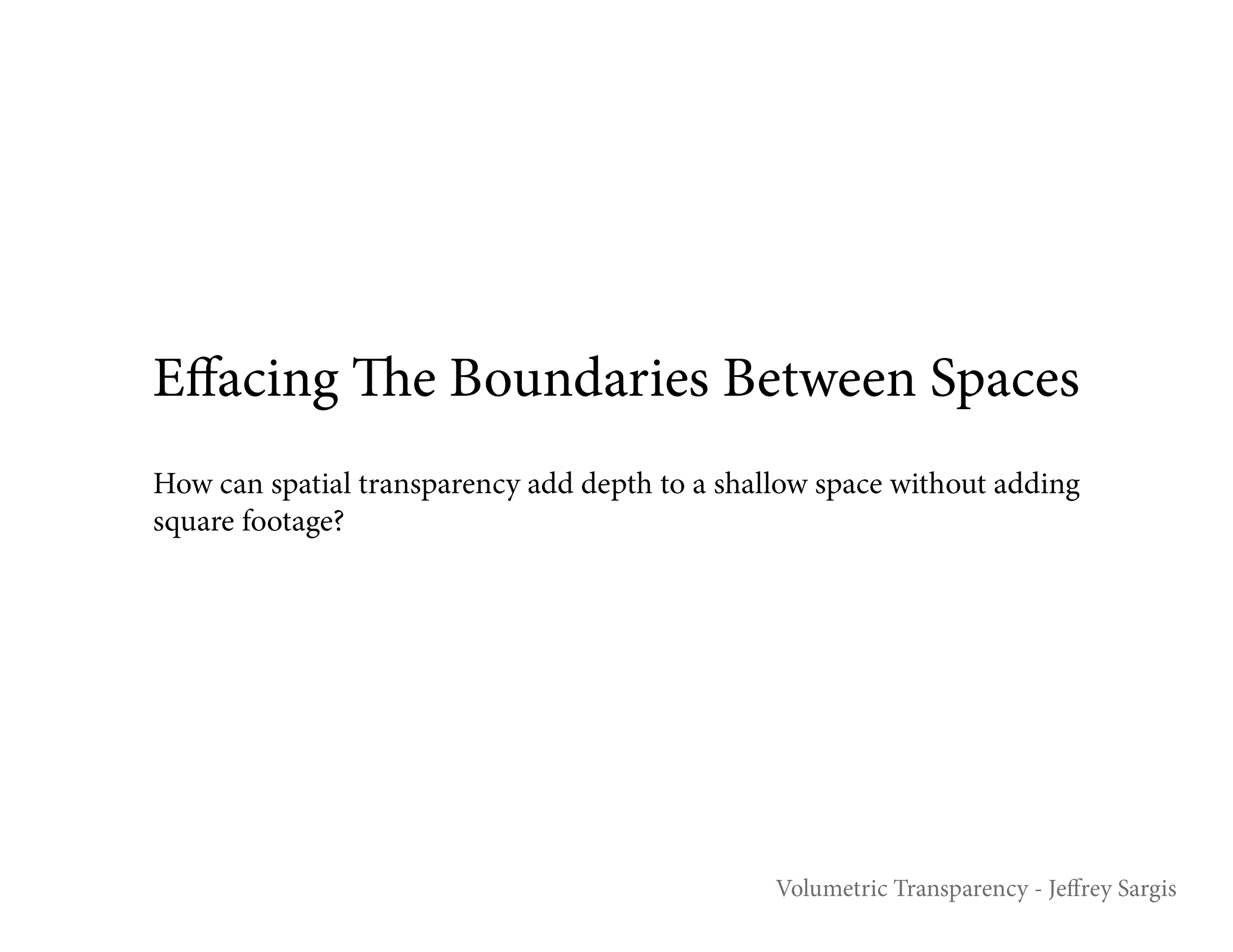
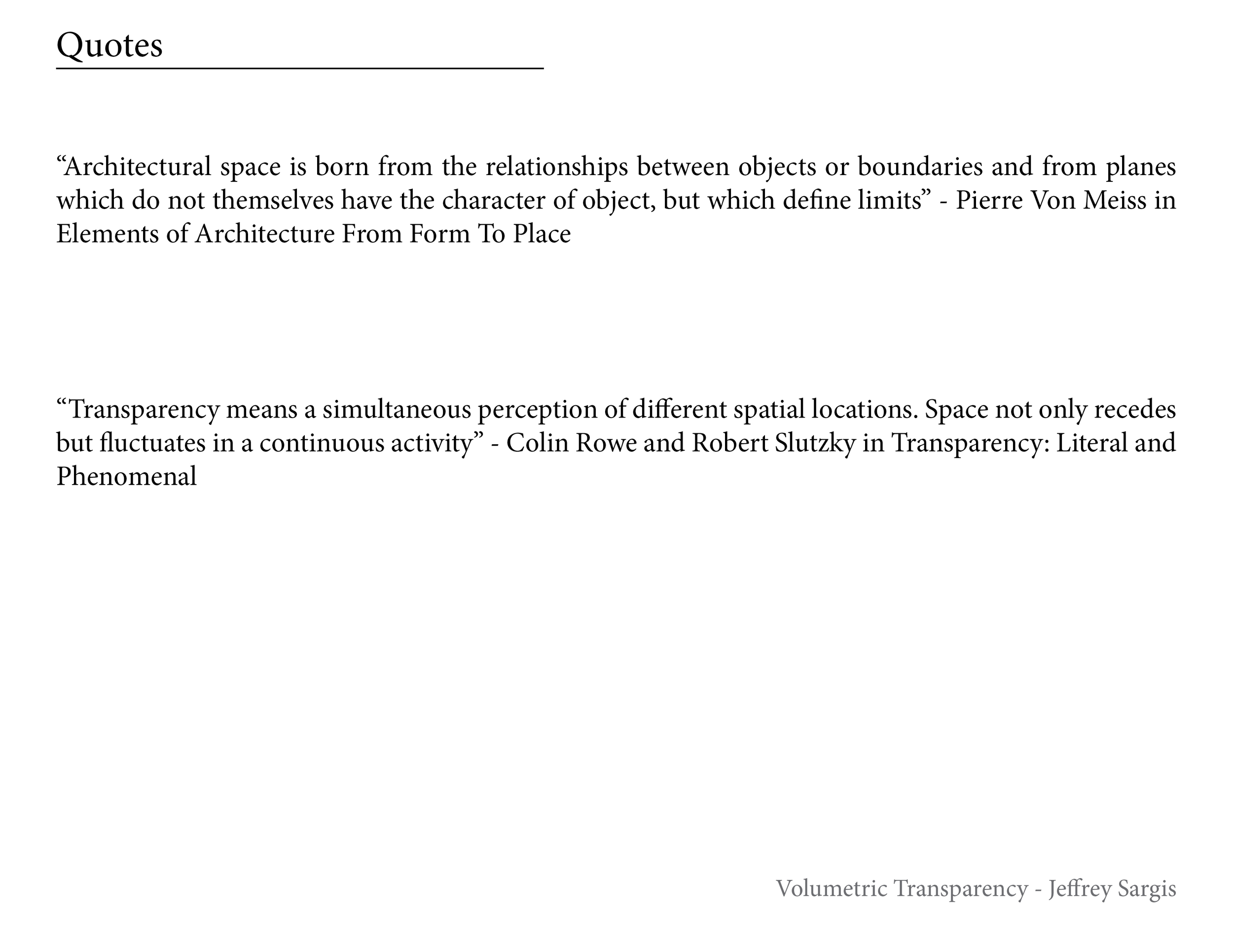
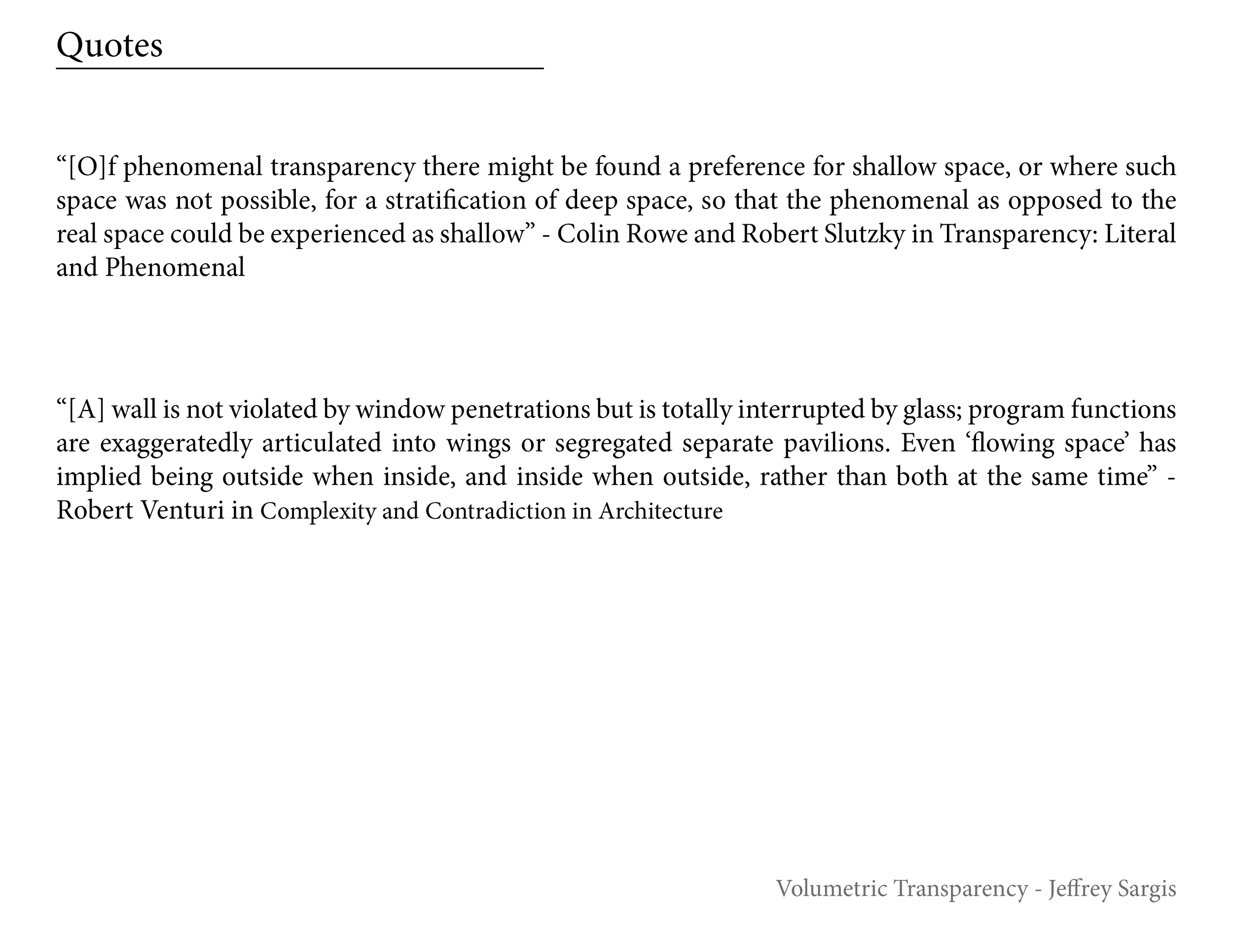
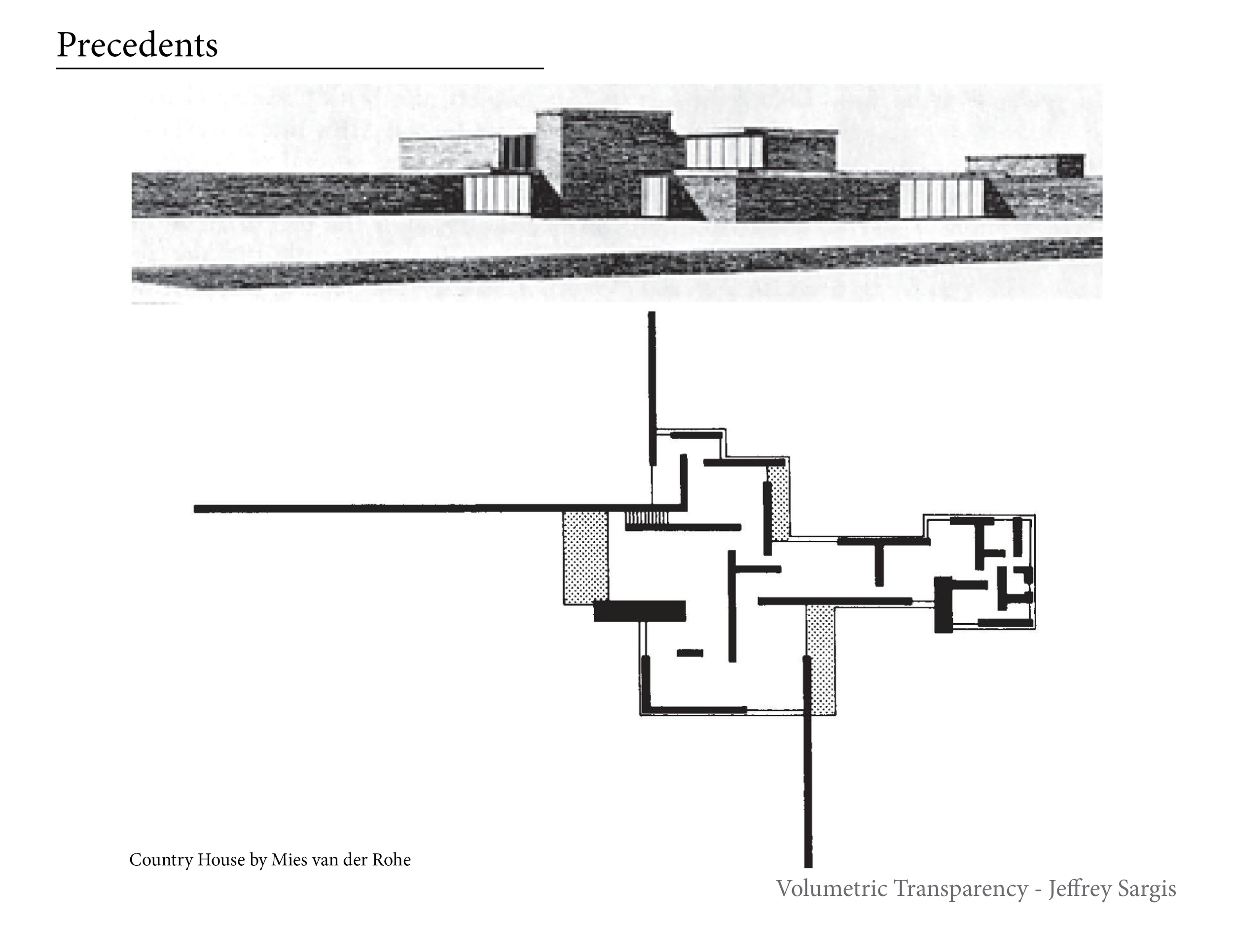
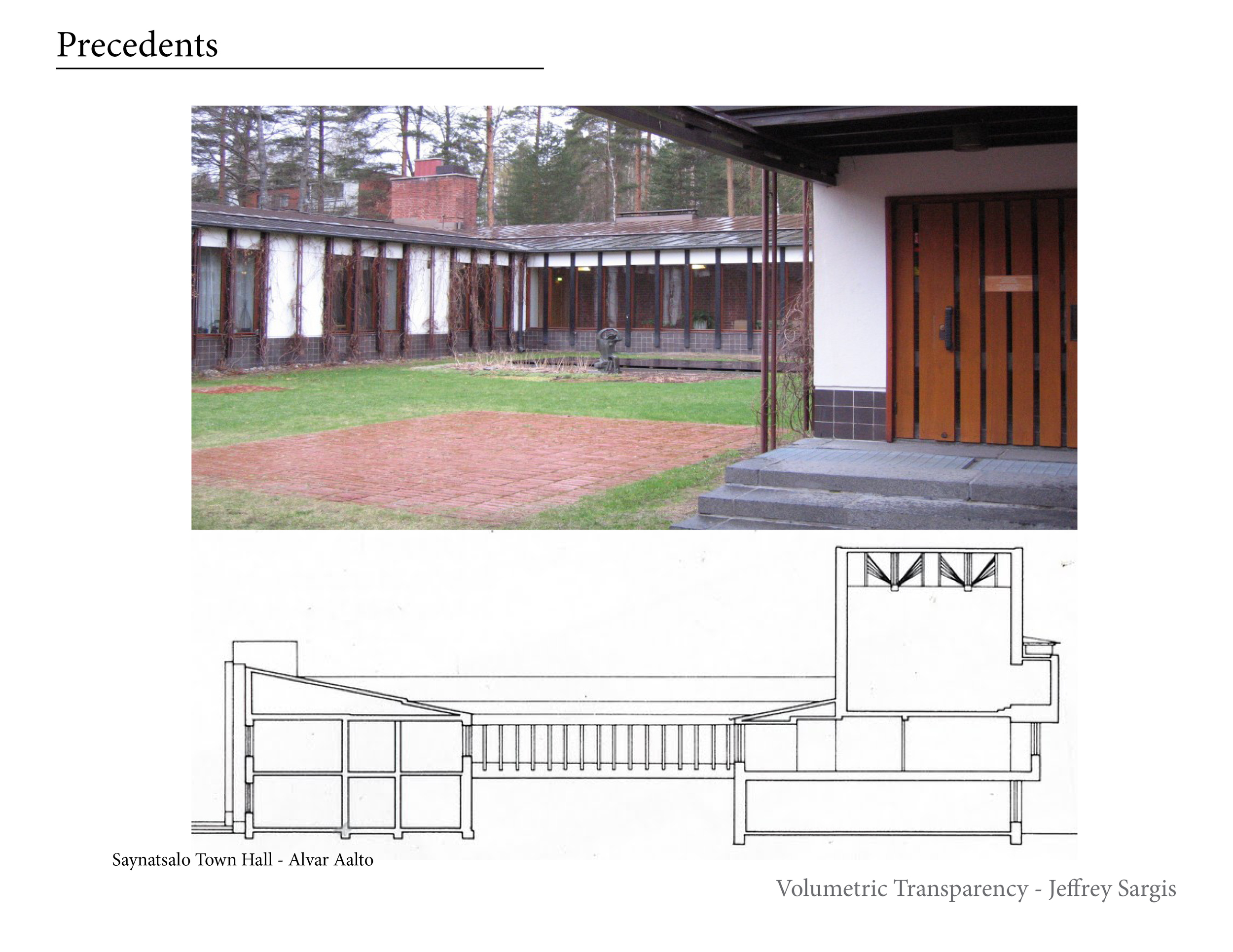


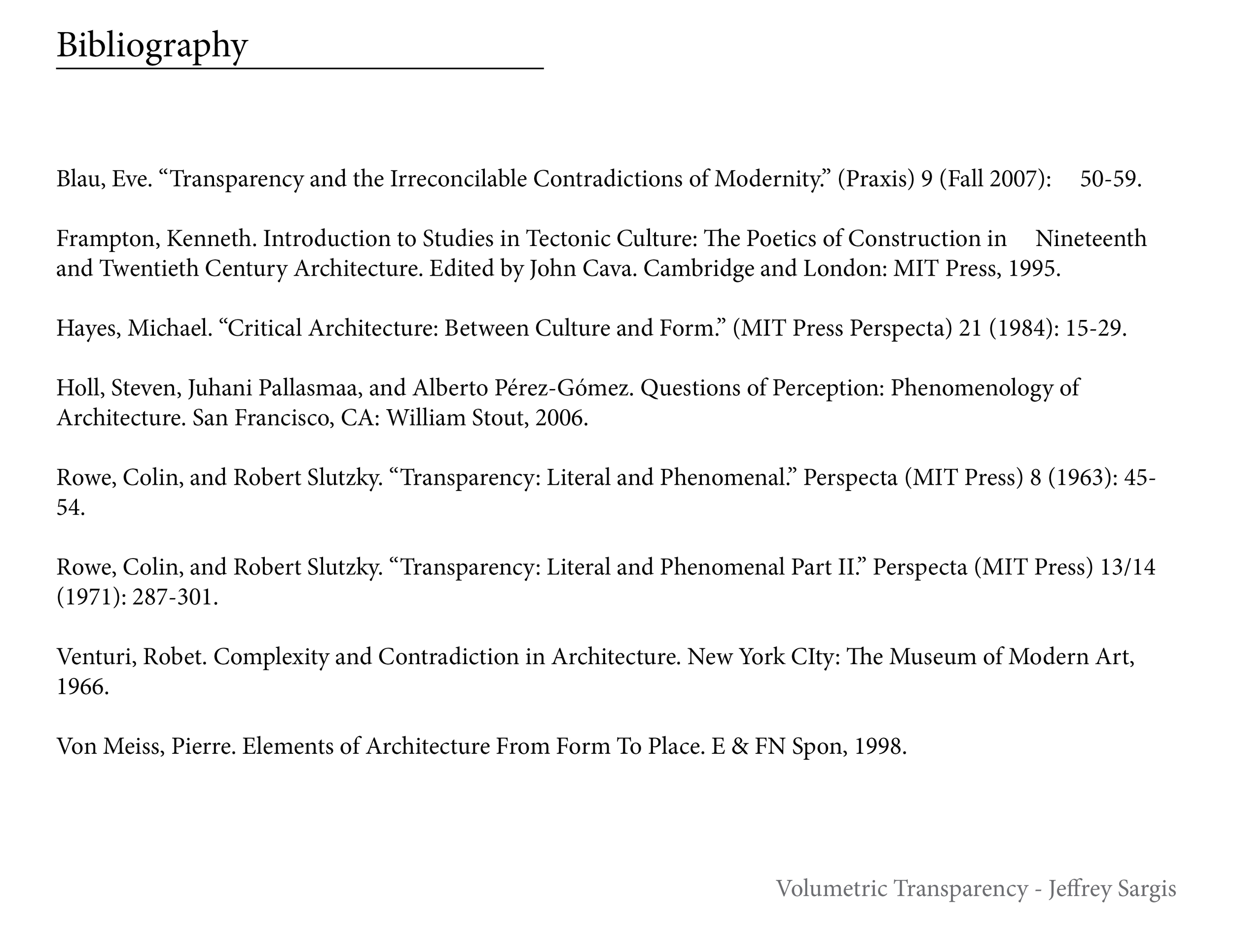
Studio Process Work: Study Models
Assignment E: Bibliographic Essay
Visually, spaces are perceived with transparency when they have overlays, extensions and their boundaries blur at certain points. These observations are found throughout various works and they concentrate on visual perceptions of space. One of these concepts illustrated by Eve Blau includes abstracted spaces that create an image similar to cubist paintings where the user is constantly viewing spaces that intertwine and relate. The relationships are formed from the basic roots in tectonic style that controls how one sees a room such as heavy or light, shallow or deep. These different methods of overlaying and showing ambiguity abstractly within spaces merges and shifts programs to alter our ideas on how these spaces are associated. These perceptions not only include overlays but a sense of the beyond and the shortening and the extending of a space. Ambiguities within spaces that make associations between two or more areas are referenced to explain the phenomenal perceptions of a larger layout. The occupant’s assessments and perceptions about a space is directly associated with spatial relations, ambiguities, tectonics, and perceived barriers. These aspects all inform and contribute to the ideas behind the perception of phenomenology. As discussed in Eve Blau’s (2007) essay “Transparency and the Irreconcilable Contradictions of Modernity” architecture in its most abstract views can play with the same tools as Cubism. This article defines transparency through its visual and physical phenomena’s by the juxtaposition of spaces and the literal qualities of the materials. “By means of carefully juxtaposed images and a shared vocabulary of term – transparency, interpenetration, movement, lightness, elasticity, dematerialization, and limitlessness – to describe [buildings of that era]” (Blau Fall 2007, 52). Her support is drawn from “the fluctuating figures of Le Corbusier’s villas” (Blau Fall 2007). Furthermore, Blau asserts that this notion of phenomenal transparency in architecture branched from experiments in photography and film, especially Mies Van der Rohe’s collaboration with artists’ experiments with light and movement. (Blau Fall 2007). Blau connects these experiments with Van der Rohe’s buildings, which like the projections from the artist films lightly define the limits of spaces as minimally as possible. This article is written for architectural scholars to better understand the different types, especially the abstract, of transparencies and how they can be utilized. Blau’s elements of transparency are used as tools to create and manipulate perceived spaces. Like Eve Blau Michael Hayes addresses how transparency was influenced by a cultural shift. His focus, however, is different from Blau’s in that he attributes the change and desire to create subtle interest in space in response to the modern state where we are constantly being bombarded by exterior stimuli. Michael Hayes’ (1984) article Critical Architecture: Between Culture and Form analyzes architecture’s relationship to the changing times and the needs of new generations. He supports his claim by using case studies and psychological academic sources that reference the effects that over stimulation have on a person. These sources then inform how architects, notably Mies van der Rohe, responded to this rush of external modern stimuli. “[A] building form conceived not in terms of separate, articulated masses related to one another by a geometrically derived core, but as a complex unitary volume that does not permit itself to be read in terms of an internal formal logic” (Hayes 1984, 19). This description of Mies’s Friedrichstrasse skyscaper exemplifies a new form and spatial view of architecture. He rebels against the older formal layout to create an interpretive mobile organization that better responds to the new modern era. The article’s concepts are used to blend different spaces so that organization is dependent on the user and reinterpreted by the individual. Mies van der Rohe accomplished blending spaces within his buildings by merging and shifting programs and keeping an open plan that connected different areas of use. These two different views on a similar cultural phenomenon relate and explain how the change in perceptions has formed transparency.
Throughout history tectonic have been used to inform spatial properties and create a feeling within a space. In a chapter from Kenneth Frampton’s (1995) “Introduction to Studies in Tectonic Culture: The Poetics of Construction in nineteenth and Twentieth Century Architecture” he seeks to explore how the tectonic “poetics of structure and construction” (Frampton 1995) evolve throughout time in different cultures. This book’s chapter excerpt focuses on tectonic meanings, origin and uses. The author presents a walk through the history of tectonics in different cultures, focusing on completed works and their building techniques in order to define a methodology in their use for the occupant. Frampton defines how tectonics has developed throughout cultures and how it can be used to engage the occupant in their surroundings. The tectonic elements are used to alter the feeling of a space. Materials and space are essential in forming spatial perceptions. Kenneth Frampton writes about how tectonics have been used and evolved over time, while Steven Holl, Juhani Pallasmaa, and Alberto Pérez-Gómez write poetically about the poetics of their uses. Fundamentally linked to ideas about spatial perceptions are Steven Holl’s, Juhani Pallasmaa’s, and Alberto Pérez-Gómez’s book “Questions of Perception: Phenomenology of Architecture.” This book is composed of three essays that are thematically linked by the idea that all the senses are needed to completely experience architecture. They assert that human perception and phenomenology play the largest role in architecture. The authors provide evidence to this claim by referencing case studies and outlining buildings to provide examples of how materials and methods are used. “Within the experimental continuum of enmeshed space, we understand distinct objects, distinct fields, as a “whole.” (Holl, Pallasmaa and Pérez-Gómez 2006, 48). It narrates the methods necessary to engage all of the occupant’s senses and create elements that will influence the user’s experience inside a piece of architecture. Two approaches written years apart however they still have similar underlying notions about how materials and the built influence the occupants perception.
Pierre Von Meiss’s “Elements of Architecture From Form To Place” asserts that spatial relationships are born from what the user perceives as boundaries. He describes how forms are created by ideas of what space is and how they are defined by elements that hint at boundaries or combined spaces. He begins his discussion by breaking down the box and the mindset of a wall and cites examples of porosities and free plans that maintain a sense of place. “Architectural space is born from the relationships between objects or boundaries and from planes which do not themselves have the character of object, but which define limits” (Von Meiss 1998, 101). These limits define space and relate them to one another conceptually. The limits are either outlined or intersected which create related areas where their organization can be reevaluated and rediscovered. The spatial designs of Pierre Von Meiss and Robert Venturi are both determined by their ideas on the limits of space. They both discuss how space is determined and manipulated by different kinds of or lack of a definite outline. Robert Venturi’s “Complexity and Contradiction in Architecture” discusses the phenomenological aspects of architecture. He analyses the complex uses of contradiction by highlighting ambiguity and relationships in spaces and forms to add depth to architectural design.
“[A] wall is not violated by window penetrations but is totally interrupted by glass; program functions are exaggeratedly articulated into wings or segregated separate pavilions. Even ‘flowing space’ has implied being outside when inside, and inside when outside, rather than both at the same time” (Venturi 1966, 31).
These views on spatial interactions inform how to create volumes that share limits and create a sense of completeness within two different areas. The concept of contradiction in architecture can create a complex space from simple shapes out of bounds and create contradictions in its form that will incorporate other interlocking spaces make a once simple shape relationships more complex and rich.
Colin Rowe’s and Robert Slutzky’s “Transparency: Literal and Phenomenal” claims that “Transparency means a simultaneous perception of different spatial locations. Space not only recedes but fluctuates in a continuous activity” (Rowe and Slutzky 1963). This assertion that architecture can be viewed equally from more than one point of view at more than one time creates a dynamic within the buildings order. To support their claim Rowe and Slutzky cite buildings from influential architects that display a duality of space, planes and structure.
“Similar parallels are very obvious in considering the organization of the principal floor. For here the vertical equivalent of deep space is introduced by the double height of the outer terrace and by the void connecting living room with entrance hall; and here, just as Leger enlarges spatial dimensions through the displacement of the inner edges of his outer panels, so Le Corbusier encroaches upon the space of his central area.” (Rowe and Slutzky 1963, 51).
The author’s purpose was to communicate the possible contrasting understandings of transparency in terms of it’s literal and phenomenal realities in order to add depth to a once simplified concept of design. Given the technical writing in the article the intended audience are architectural professionals, scholars and art theorists. Colin Rowe’s and Robert Slutzky’s discussions on transparency illustrates its expression within architecture. Colin Rowe’s and Robert Slutzky’s “Transparency: Literal and Phenomenal Part II” continues from their first discussion on transparency and extends it to encompass historical precedents. The authors continue their explanation of perceived overlaps and contradictions in space only now they apply it to all time periods instead of just the modernist ear.
“[O]f phenomenal transparency there might be found a preference for shallow space, or where such space was not possible, for a stratification of deep space, so that the phenomenal as opposed to the real space could be experienced as shallow” (Rowe and Slutzky 1971, 288).
This explanation of the phenomena explains the ambiguity between shallow and deep space and its implications within a space. To support their claim they diagram façade organizational layouts from renaissance and modern architecture along with implied shape recognition associations to show examples of different ordering interpretations. The authors communicate the contrasting understandings of these forms of transparency in familiar terms and simple diagrams so the viewer can see different hierarchies in façades and forms. The compared and contrasted works are models to how designers achieve this phenomena and how viewers register its effect.
All of the combined attributes coincide to create spatial qualities that are perceived and show as phenomenal transparency. Each source describes how different time periods created and expressed this phenomenon differently. Some ways have been influenced by the extremely abstract and others the orderly archaic. Many examples of transparency have been in response to changing eras such as modernity. When the users experience these effects one can see how it can be influential in adding richness to their viewed space, thus creating phenomenal transparency.
Bibliography
Blau, Eve. "Transparency and the Irreconcilable Contradictions of Modernity." (Praxis) 9 (Fall 2007): 50-59.
Frampton, Kenneth. Introduction to Studies in Tectonic Culture: The Poetics of Construction in Nineteenth and Twentieth Century Architecture. Edited by John Cava. Cambridge and London: MIT Press, 1995.
Hayes, Michael. "Critical Architecture: Between Culture and Form." (MIT Press Perspecta) 21 (1984): 15-29.
Holl, Steven, Juhani Pallasmaa, and Alberto Pérez-Gómez. Questions of Perception: Phenomenology of Architecture. San Francisco, CA: William Stout, 2006.
Rowe, Colin, and Robert Slutzky. "Transparency: Literal and Phenomenal." Perspecta (MIT Press) 8 (1963): 45-54.
Rowe, Colin, and Robert Slutzky. "Transparency: Literal and Phenomenal Part II." Perspecta (MIT Press) 13/14 (1971): 287-301.
Venturi, Robet. Complexity and Contradiction in Architecture. New York CIty: The Museum of Modern Art, 1966.
Von Meiss, Pierre. Elements of Architecture From Form To Place. E & FN Spon, 1998.
Assignment D Annotated Bibliography, Précis revised
Theoretical Transparency within spatial relationships. A common thread found throughout these various works is the concentration on the visual perceptions of space. Some of these concepts include abstracted spaces that create feelings similar to ones found in viewing a cubist painting where the user is constantly reassessing which spaces intertwine or relate. The relationships are formed from the basic roots in tectonic style that control how one sees a room such as heavy or light and shallow or deep. These different methods of overlaying and showing ambiguity abstractly, within spaces, merge and shift program to alter our ideas on how these spaces are associated. These perceptions not only include overlays but a sense of the beyond and the shortening and the extending of a space. Ambiguities within spaces that make associations between two or more areas are referenced to explain the phenomenal perceptions of a larger layout. The occupants assessments about a space and how they perceive it is directly associated with spatial relations, ambiguities, tectonics, and perceived barriers.
Annotated Bibliography
Blau, Eve. Transparency and the Irreconcilable Contradictions of Modernity, PRAXIS 9 (fall 2007): 50-59
(Have PDF)
This article defines transparency through its visual and physical phenomena’s by the juxtaposition of spaces or the literal qualities of the materials. This article is written for architectural scholars to better understand the different types of transparencies and when to utilize them. Blau’s defined elements of transparency are used as tools to create and manipulate perceived spaces.
Frampton, Kenneth. Introduction to Studies in Tectonic Culture: The Poetics of Construction in nineteenth and Twentieth Century Architecture Edited by John Cava (Cambridge and London: MIT Press), 1-27.
(Have PDF)
This source is a chapter excerpt from a book focusing on tectonic meanings, origin and uses. The author presents a walk through the history of tectonics in different cultures, focusing on completed works and their building techniques in order to define a methodology in their use for the occupant. This book is written for an audience of researchers, students and architectural scholars. Frampton defines how tectonics has developed throughout cultures and how it can be used to engage the occupant in their surroundings. The tectonic elements are used to alter the feeling of a space.
Hayes, Michael. Critical Architecture: Between Culture and Form MIT Press Perspecta, Vol. 21 (1984), pp. 15-29
(Have PDF)
This source is a critical article on culture and form. This article analyzes architecture’s relationship to the changing times and the needs of new generations. They support their claim through case studies and psychological academic sources. The concepts overviewed are used to blend different spaces. Mies van der Rohe accomplished blending spaces within his buildings by merging and shifting programs and keeping an open plan that connected different areas of a person’s lifestyle.
Holl, Steven, Juhani Pallasmaa, and Alberto Perez Gomez. Questions of Perception: Phenomenology of Architecture. San Francisco, CA: William Stout, 2006.
(Have Book)
This source is a book composed of three essays that are thematically linked by the idea that all the senses are needed to completely experience architecture. They assert that human perception and phenomenology play the largest role in architecture. The authors provide evidence to this claim by referencing case studies and outlining the buildings to provide examples of how materials and methods are used. The essays are written for an audience of researchers, students and architectural scholars. It outlines the methods necessary to engage all of the occupant’s senses to create elements that will influence the user’s experience inside a piece of architecture.
Von Meiss, Pierre. Elements of Architecture From Form To Place. E & FN Spon (1998), pp. 101-114
(Read at BPL)
Pierre Von Meiss’s Elements of Architecture From Form To Place asserts that spatial relationships are born from what the user perceives as boundaries. He describes how forms are created by ideas about what space is and that they are defined by elements that are present and hint at boundaries or combined space. He begins his discussion by breaking down the box and the mindset of a wall and cites examples of porous walls and free plans that maintain a sense of place. These ideas are incorporated into how different spaces can relate to one another on a conceptual level in the user’s mind.
Rowe, Colin, Robert Slutzky. Transparency: Literal and Phenomenal MIT Press Perspecta, Vol. 8 (1963), pp. 45-54
(Have PDF)
Colin Rowe’s and Robert Slutzky’s Transparency: Literal and Phenomenal asserts that architectural elements can be viewed equally from more than one point of view. To support their claim they cite buildings from influential architects that display the duality of space, planes and structure. The author’s purpose was to communicate the possible contrasting understandings of transparency in terms of it’s literal and phenomenal realities in order to add depth to a once simplified concept of design. Given the technical writing in the article the intended audience are architectural professionals, scholars and art theorists.
Rowe, Colin, Robert Slutzky. Transparency: Literal and Phenomenal Part II. MIT Press Perspecta, Vol. 13/14 (1971), pp. 287-301
(Have PDF)
Colin Rowe’s and Robert Slutzky’s Transparency: Literal and Phenomenal Part II continues from their first discussion on transparency and extends it to encompass historical precedents. To support their claim they diagram façade organizational layouts and implied shape recognition associations showing examples of different ordering interpretations in architecture. The authors communicate the contrasting understandings of these forms of transparency in terms that the viewer can see different hierarchies in façades and forms. Given the technical writing in the article the intended audience are architectural professionals, scholars and art theorists.
Venturi, Robert. Complexity and Contradiction in Architecture. The Museum of Modern Art, New York (1966)
(Have Book)
Robert Venturi’s Complexity and Contradiction in Architecture discusses the phenomenological aspects of architecture. He analyses the complex uses of contradiction by highlighting ambiguity and relationships in spaces and forms to add depth to architectural design. These views on spatial interactions inform how to create volumes that share limits and create a sense of completeness within two different areas. The concept of contradiction in architecture can create a complex space from simple shapes and create contradictions in its form. These other interlocking spaces make a once simple shape relationship more complex and rich.
Assignment C Rhetorical Precis: Analysis of a Book Review and a Main Source
Daniel Naegele’s review of Colin Rowe’s “The Mathematics of the Ideal Villa and Other Essays” explains that Rowe’s essays provide conditions where ideas and buildings can be constantly questioned and developed. To support his claim Naegele quotes Rowe’s work and extracts the opposing words he uses to describe, compare and contrast different architectural situations. The author’s purpose was to explain how Rowe chooses to manipulate his vocabulary to create an ambiguous view in order to constantly raise questions that improve and evolve the architecture field. Given the technical writing in the article the intended audience are architectural professionals, scholars and art theorists.
Bibliography
Naegele’s, Daniel, reviewer. “The Mathematics of the Ideal Villa and Other Essays” [Review of the book “The Mathematics of the Ideal Villa and Other Essays”]. Harvard Design Magazine, Winter/Spring 2002, pp.81-84
Rowe, Colin, Robert Slutzky. “Transparency: Literal and Phenomenal” MIT Press Perspecta, Vol. 8 (1963), pp. 45-54
Two 2D Inspirations For A Model
After the trip to New York City two inspirations for an abstract model were chosen.
The first is a sketch interpretation created while watching Oskar Fischinger's artist film "Raumlichtkunst"
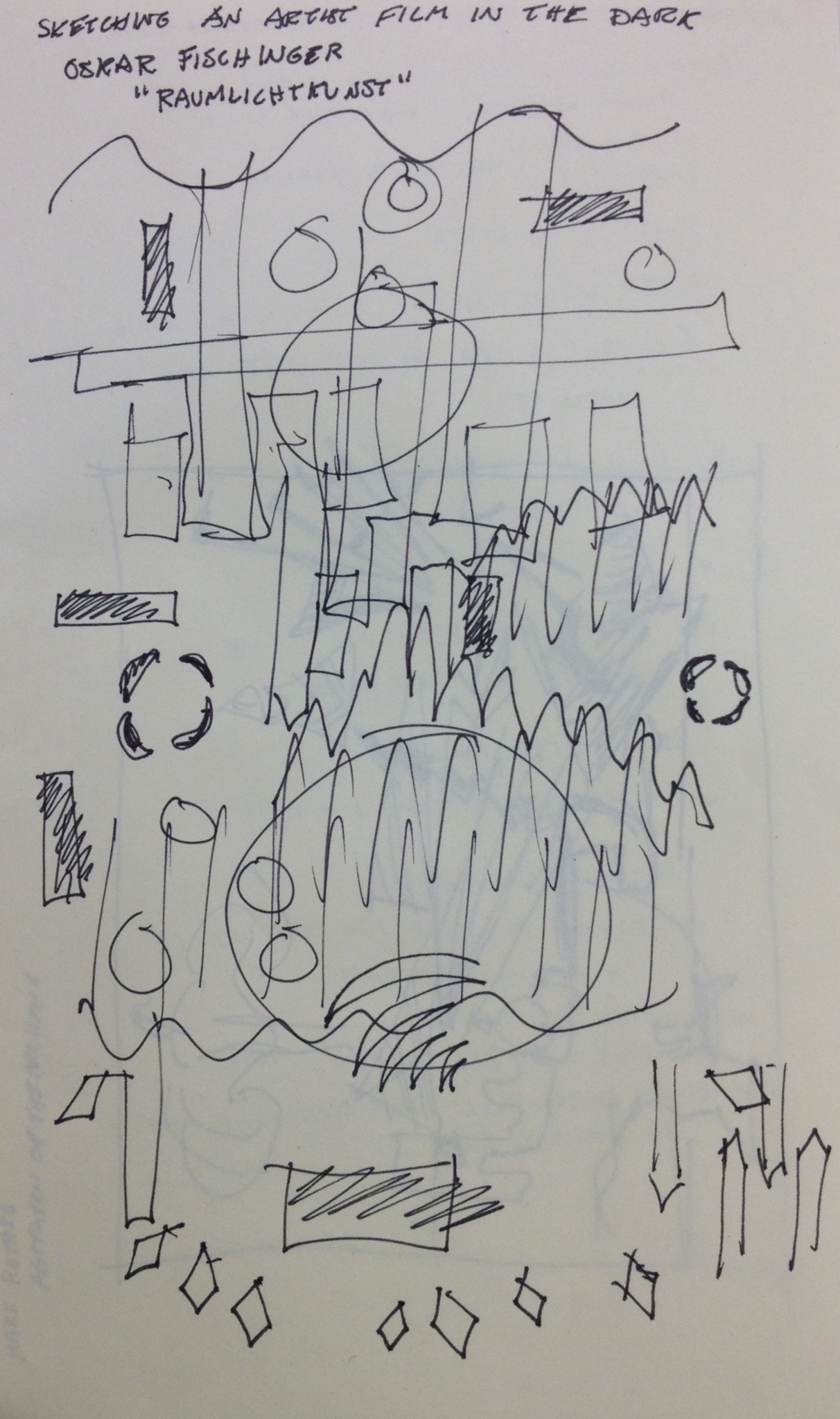
The second is a Mark Rothko painting titled "Agitation Of The Archaic"
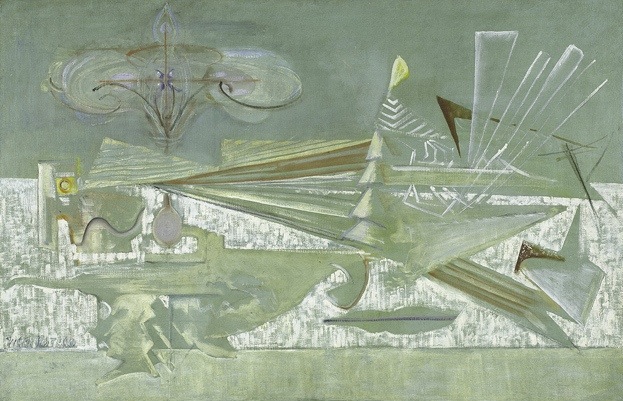
Both of these sources were drawn upon for the model.
The model's concept is layering, ambiguity and movement.
After a discussion on a previous model's rendition, it was decided that the armature was too strong of an element and needed to be broken up or reduced to better visualize the concept of ambiguity because it was clearly defining itself as a wall or reference plane. In this new iteration the first task was to pull the armature apart. Pieces were then strategically placed to overlap in various views and be seen in dialogue with one another, helping to define their placement in space. The main planes that dictate the three sections are derived from Rothko's painting where he seems to have painted three clear horizontal planes.
The pieces that are reminiscent of white picket fences were placed based on shapes discovered in Fischinger's artist film. This creates a narration that speaks of how once the American dream was to have a family and a house with a white picket fence. Rothko's painting "Agitation of the Archaic" contains objects resembling a genie lamp, old battle flags etc., all things long gone in the past. The interpretation of Rothko's painting in conjunction with the shapes from Fischinger's film suggest a new narrative on things that have now become part of the past. The white picket fences and their movement within the model suggest a interpretation that the American dream has changed and the old notion has been left behind.
The composition of the model is physically oscillating, on its hinges, as well as visually. It creates psychological experienced space where the viewer is constantly reassessing the abstract space. The user strives to see and understand the piece all at once as well as separately.
This model begins to raise the question whether architecture is part of the mind and not part of the body. It will be the precursor to the research into a building that can collapse and pull apart physically, visually or both.
Watercolor to Model Interpretation
The next iteration from an abstract 2D painting to an abstract 3D model. The painting:
The model:
The model was designed and built on the concept of ambiguity. Each piece appears either as in the foreground or background depending on how the model is oriented. The main armature was conceived from the rectangular prism located at the center of the painting.
Excercise 3.1: Sources, Annotated Bibliography Continued
Hayes, Michael. “Critical Architecture: Between Culture and Form” MIT Press Perspecta, Vol. 21 (1984), pp. 15-29 This source is a critical article on culture and form. This article analyzes architecture’s relationship to the changing times and the needs of new generations. They support their claim through case studies and psychological academic sources. This sources is useful to the thesis because it overviews the concepts used to blend the interior and exterior. Specifically Mies van der Rohe’s buildings where he attempted this exterior interior blending to connect people with the calm of the natural elements contrasting the hectic modern lifestyle.
Rowe, Colin, Robert Slutzky. “Transparency: Literal and Phenomenal” MIT Press Perspecta, Vol. 8 (1963), pp. 45-54
This source analyzes cubist artwork to describe the dynamic of phenomenal transparency. They attest that overlapping forms, that do not destroy one another’s shapes, are awarded transparency because the viewer cannot distinguish which is in the foreground and which is in the background. This source is useful to the thesis because it explores the theories of transparency. The types of transparency used are physical, the inherent quality of the material, and phenomenal, the perceived overlapping of space. These concepts can be applied to the thesis when overlapping and merging the qualities of interior and exterior spaces.
TP2: Exercise 3.1: Revised Question, Image, And Mind Map
TP1: Assignment B: Contemporary Discourses / Compare and Contrast Essay 2
Reflection
The two readings chosen for this assignment inform my thinking about my thesis question by helping me to discover how I wish to research and support my thesis topic. What I wish to learn from my thesis question is about the continuity of interior and exterior spaces. Frampton’s article reveals the uses and general theories on tectonics, which I can apply to my thesis developing the use of a building’s material language to denote interior and exterior spaces. Blau’s article teaches how transparency, both literal and visual, can cause the occupant to feel as if the adjacent spaces are connected. This understanding provides a tool to aid my research in creating continuity between interior and exterior spaces.
Each of the sources “Introduction to Studies in Tectonic Culture” by Kenneth Frampton and “Transparency and the Irreconcilable Contradictions of Modernity” by Eve Blau, recognizes a poetic non-visual non-literal aspect to tectonics. However, Frampton focuses more on the “traditional” phenomenology of tectonics, while Blau speaks on the abstract perception of spaces. Frampton proves his theory by citing examples throughout history of how materials define space and engage the inhabitant. Blau’s views are similar, however, she focuses on how the ambiguity of transparency can alter an individual’s perception of space. The user’s perception of the space’s program is constantly in motion, much like a film montage of the building’s daily programmatic lifespan. The sources both speak to how tectonics are used to create literal and phenomenological space but they differ in their abstraction of it.
In Frampton’s “Studies in Tectonic Culture” he asserts that we view space by reorganizing it based on past knowledge, that our movement into space defines it, and that structure and construction can vary the space’s expression. Frampton claims that based on our past experiences we reorganize and view a space as it has been before and theoretically should be now. “The body reconstitutes the world through its tactile appropriation of reality” (Frampton 1995, 10). He goes on to argue that tectonics create a defined space that we evaluate while we move forward into its volumes. “Our concept of space is determined by the frontalized progression of the body through space in depth” (Frampton 1995, 11). Frampton believes that a building’s expression can vary and is defined by subtle changes in its structural and material relationships. “Combinations of structure and construction could become the occasion for a subtle variation in expression” (Frampton 1995, 20). His views are constrained to a more traditional view of tectonics, one where the literal guides perception.
Eve Blau’s “Transparency and The Irreconcilable Contradictions of Modernity” argues that tectonic transparency creates literal and phenomenological spaces that have a complex layering, that move between realism and abstraction. Blau also states that these layered spaces have structural systems that when both visually and literally join they become a fully integrated work. Blau asserts that the layering of juxtaposed spaces causes them to blur into one another creating a complex interpretation of which space is positioned, without favoring one over another. “A quality of spatial organization that is ambiguous, generated by the simultaneous perception of different spatial locations and superimposed forms that appear to interpenetrate without optically destroying each other” (Blau 51). She argues that the spaces move between realism and abstraction because of the context in which they are viewed in relation to the whole of the building. For example a buildings layout can be viewed as a montage of different uses. “A conception of transparency as a function of montage: a compositional strategy of de-contextualization and re-contextualization the problematized and foregrounds the dialectical relationship between realism and abstraction” (Blau 52). Blau claims that when the literal structure and visual structure intertwine the result is a form that is perfectly complete as a whole. For example, “Mies integrates his two structural systems visually so that, perceptually, the discrepancies between them become invisible and the whole seems to cohere into a perfectly balanced and fully integrated autonomous work of art” (Blau 57). Her views on perception are founded in the abstract and how clarity can be altered and questioned.
As discussed, tectonic expression is prominent in both articles but the idea differs in how its use is executed. Kenneth Frampton takes a more traditional approach on how tectonics and materiality are expressed. His views are more realistic than abstract due to the concept of how materials express the space and move the person throughout it. Eve Blau discusses using transparency to blur and restructure the spaces causing the person to constantly be reassessing their understanding of the space. Her views on perceived space and programmatic uncertainty create an abstract dynamic dialogue between the user and the designed layout. Both articles articulate the profound influence different types of tectonics have on the occupant.
Bibliography
Blau, Eve. “Transparency and the Irreconcilable Contradictions of Modernity,” PRAXIS 9 (fall 2007): 50-59
Frampton, Kenneth. “Introduction to Studies in Tectonic Culture: The Poetics of Construction in nineteenth and Twentieth Century Architecture” Edited by John Cava (Cambridge and London: MIT Press), 1-27.
